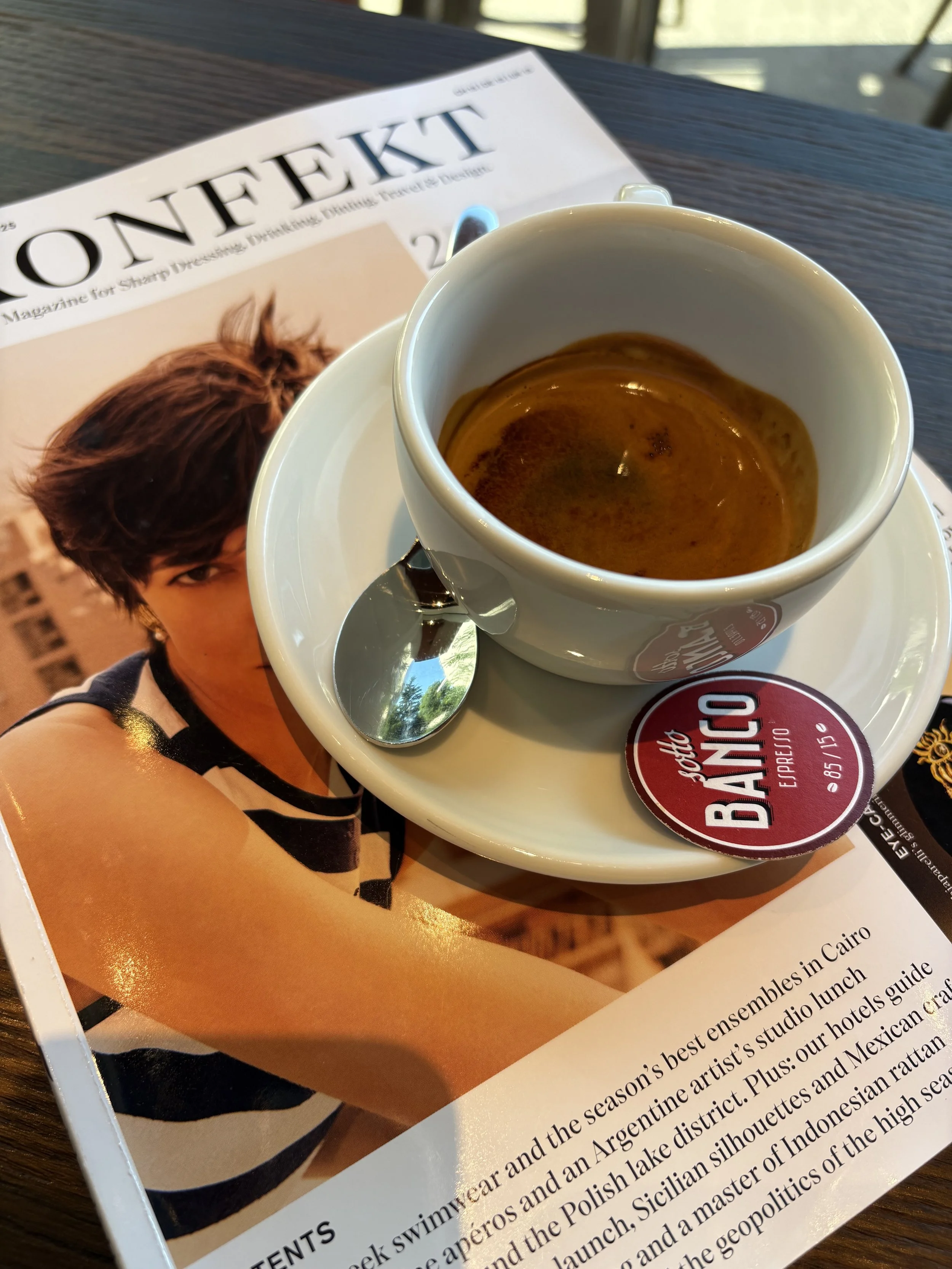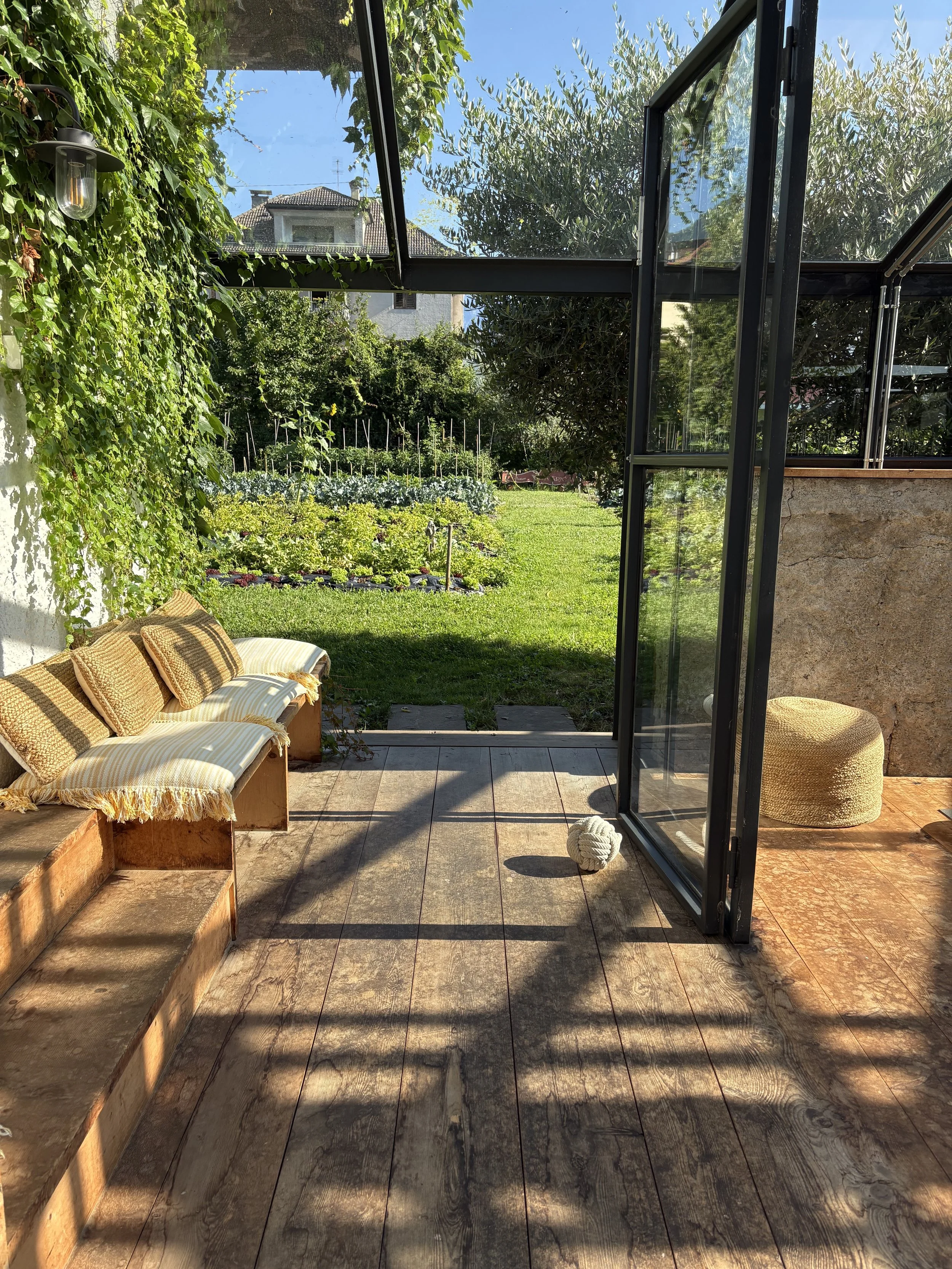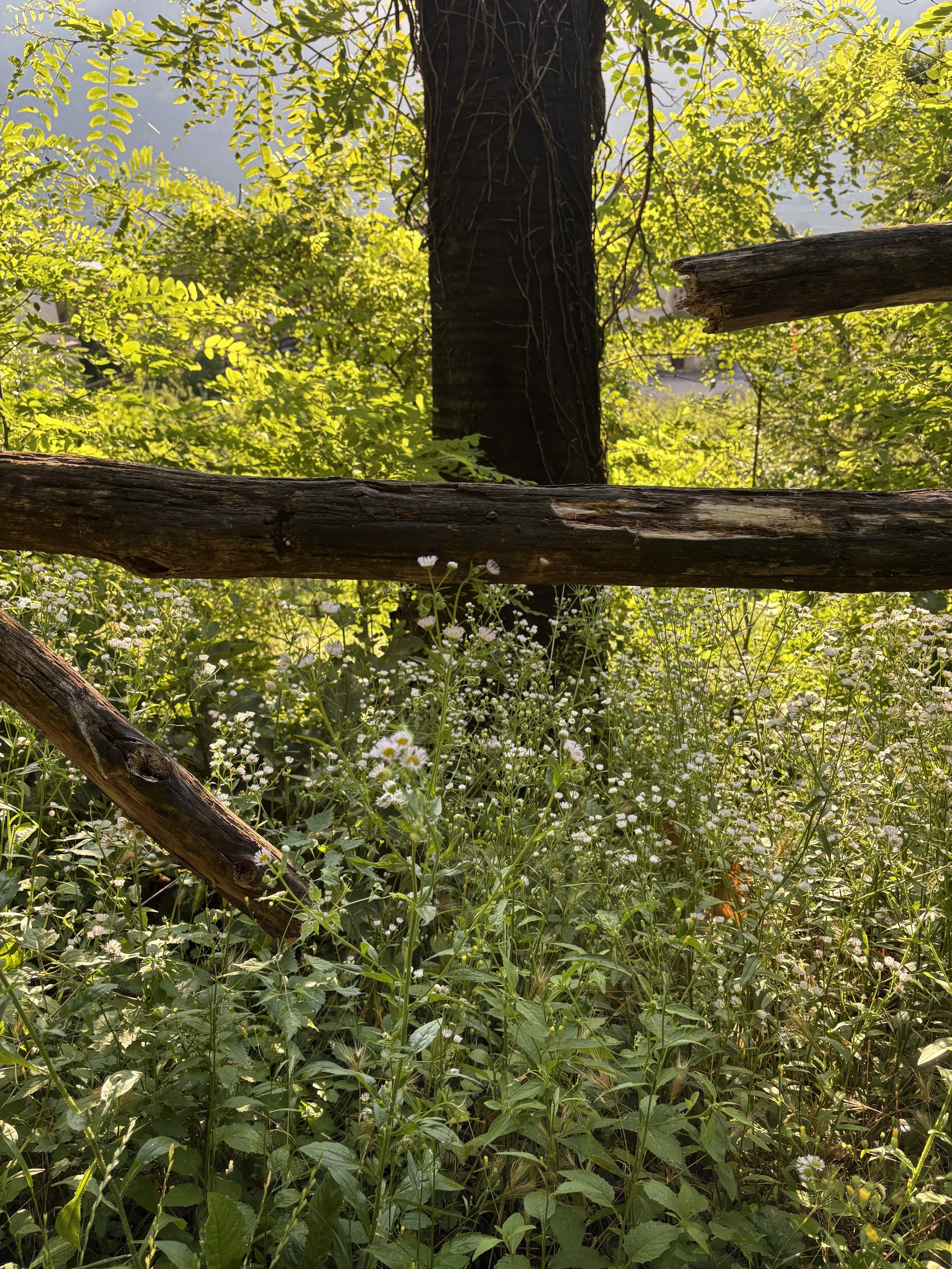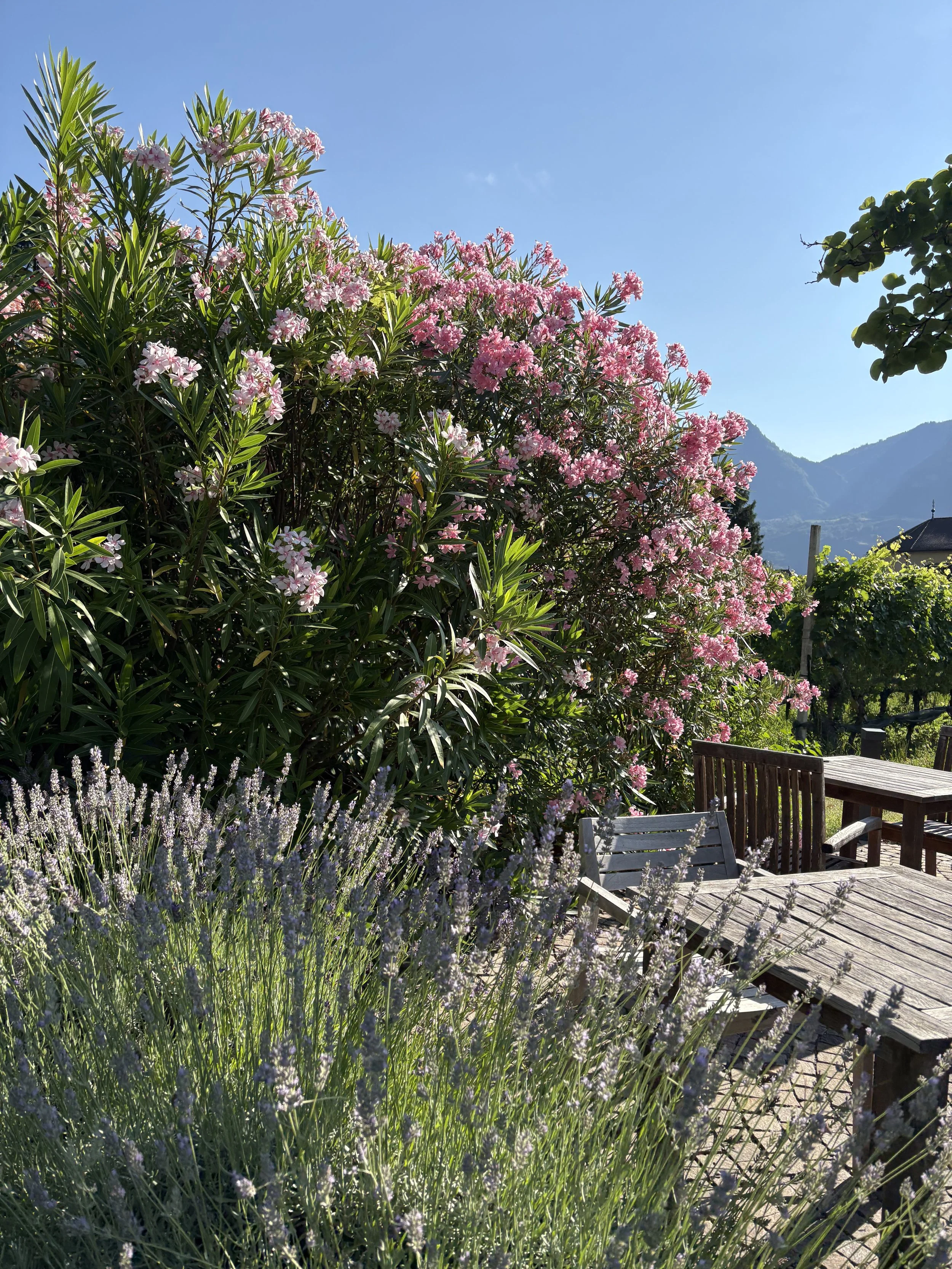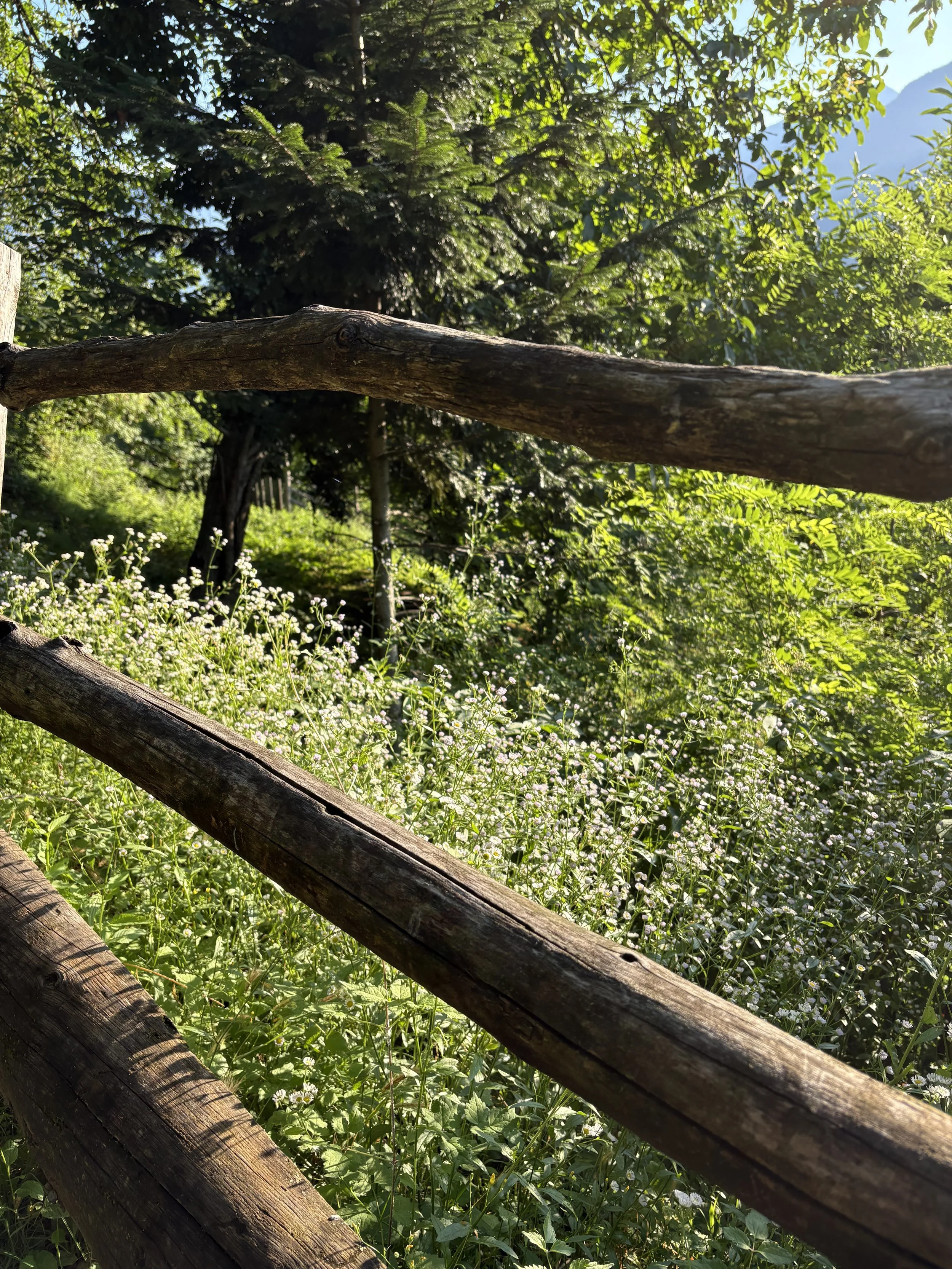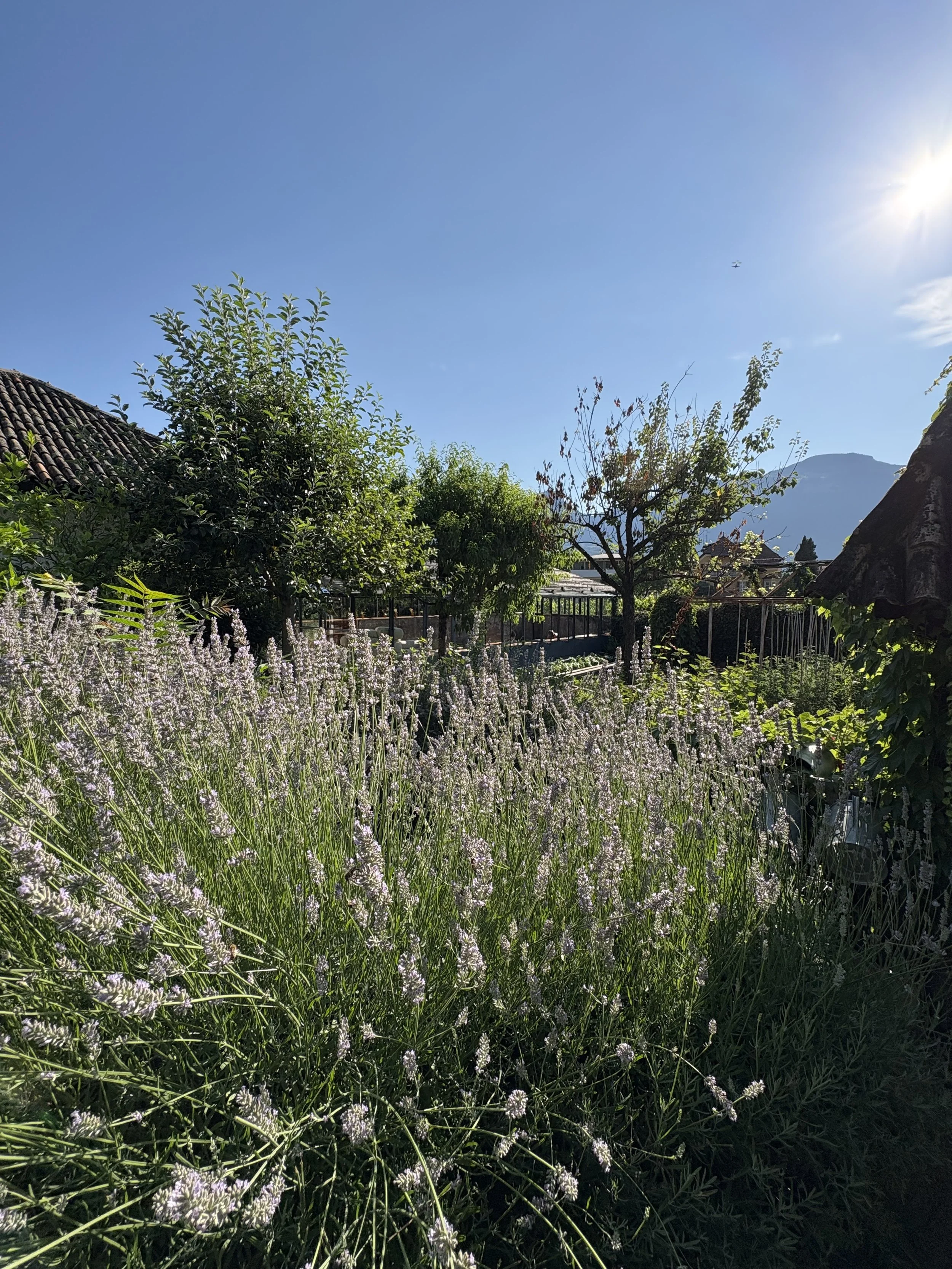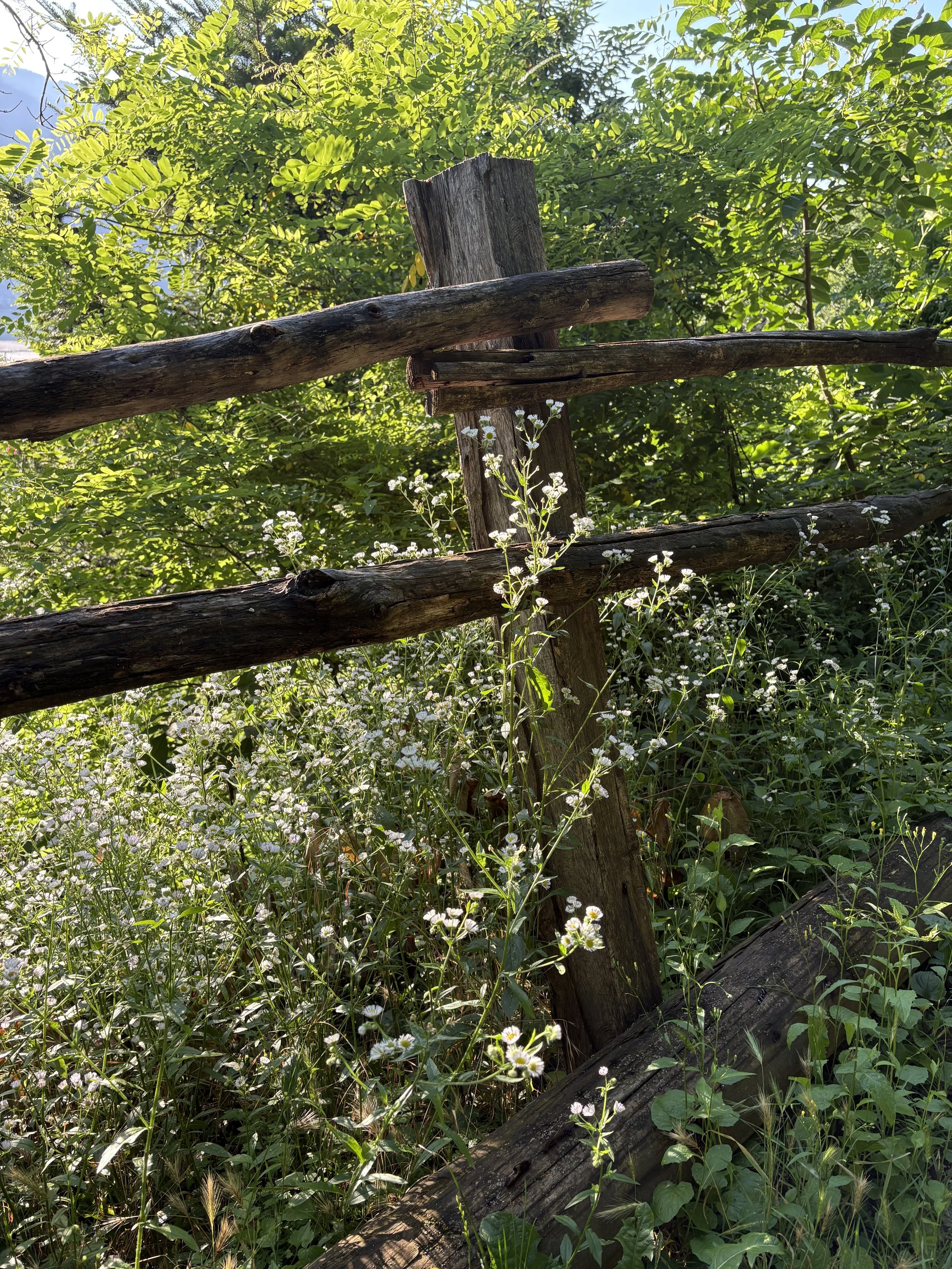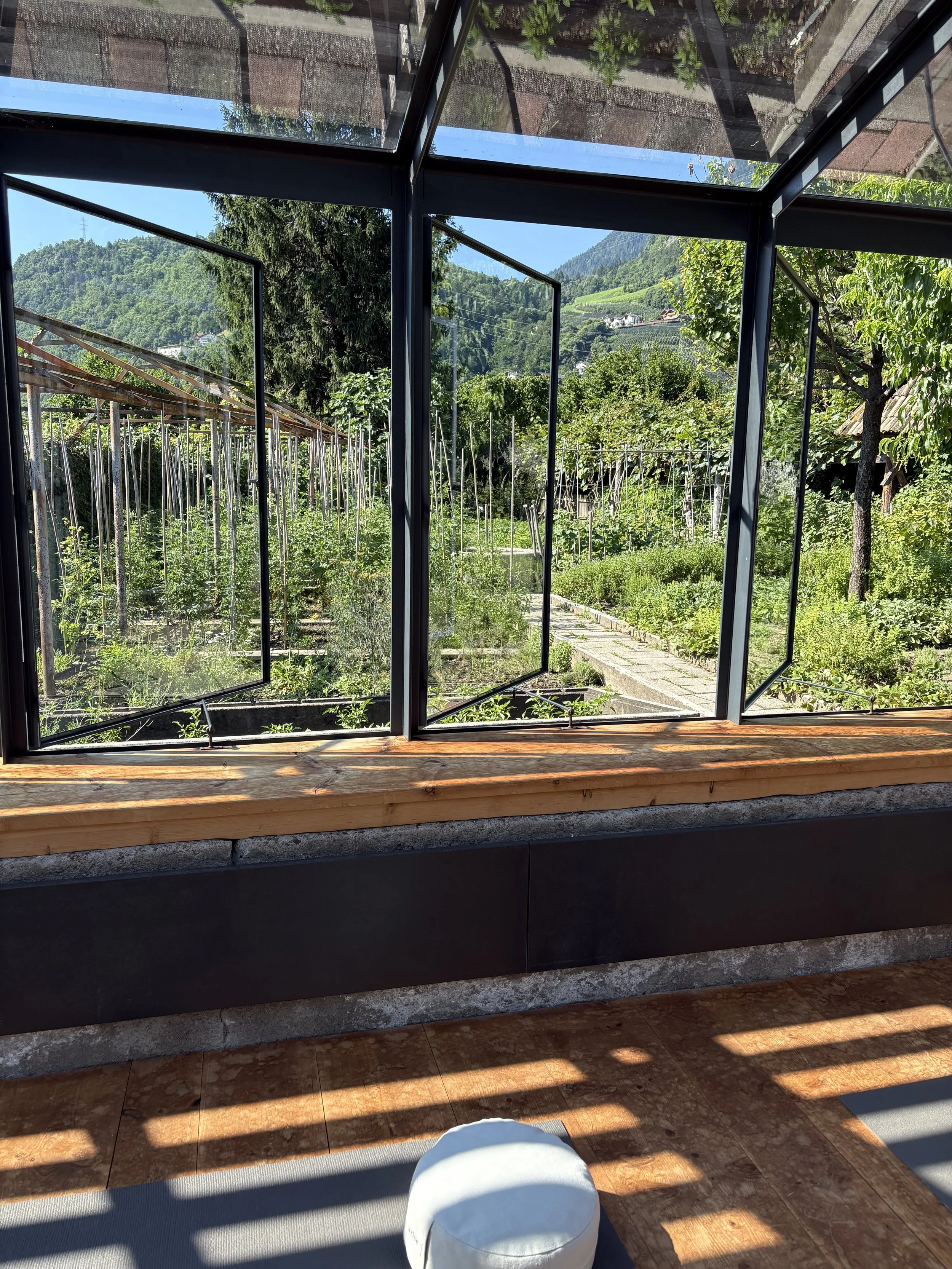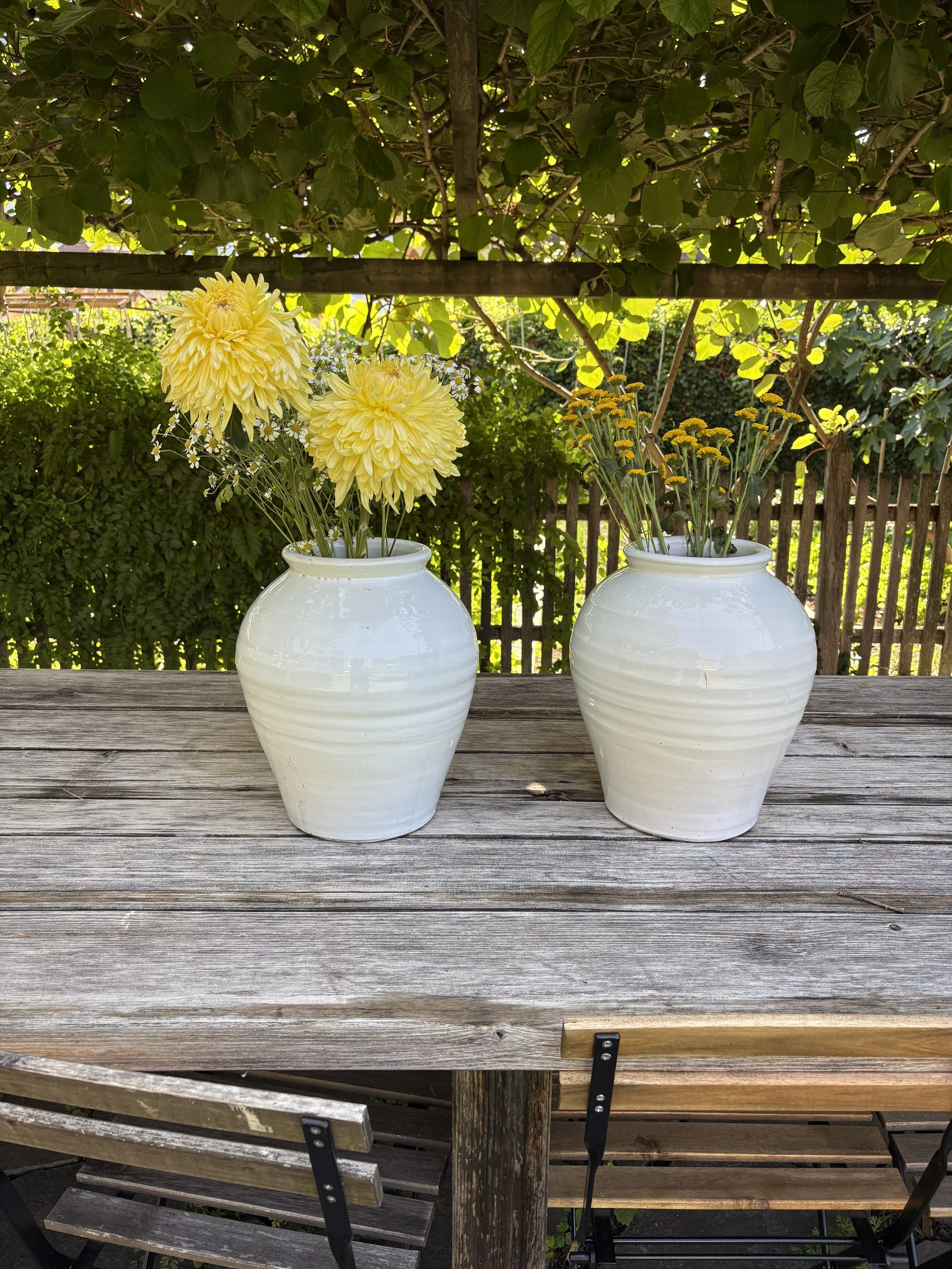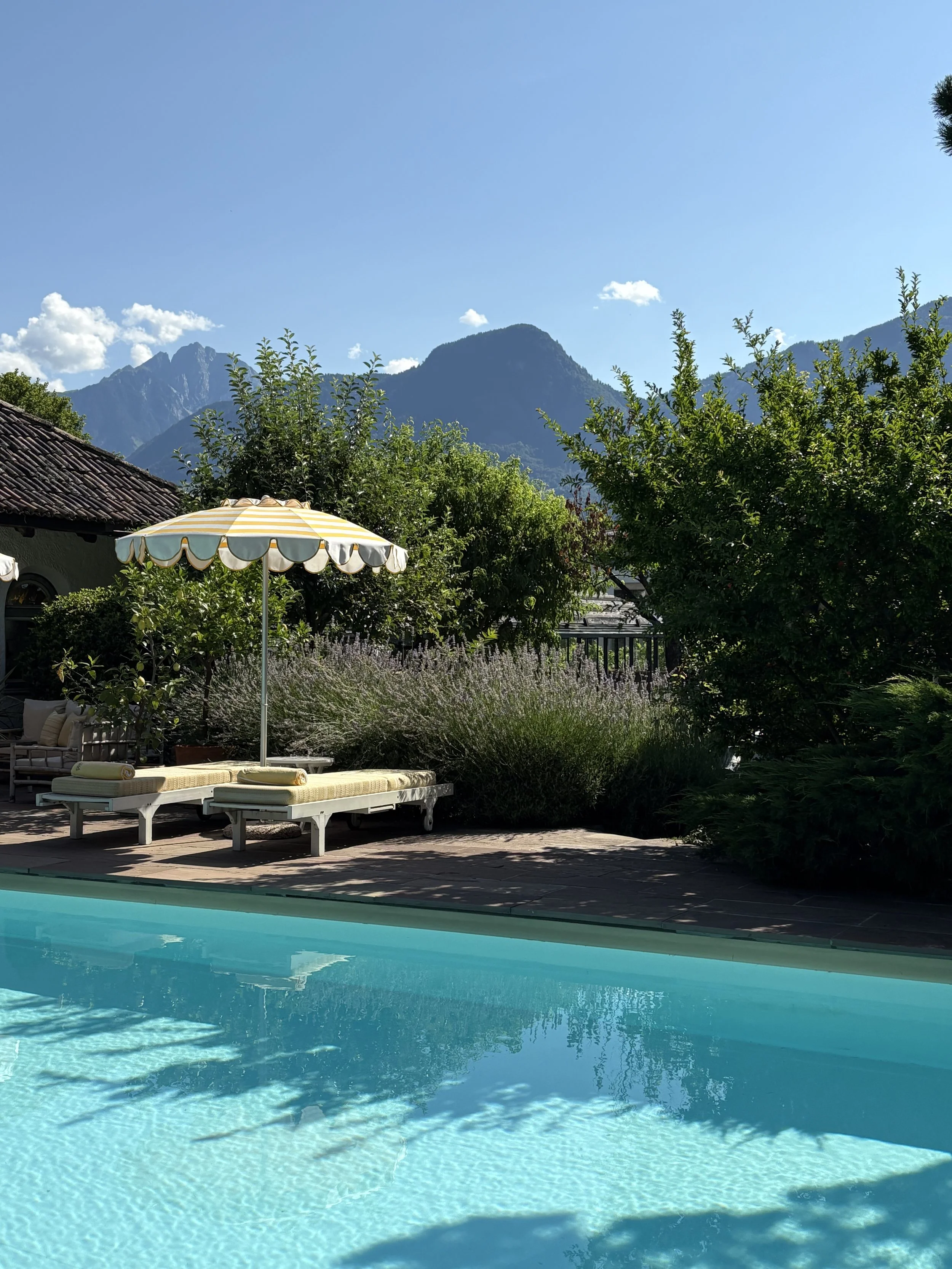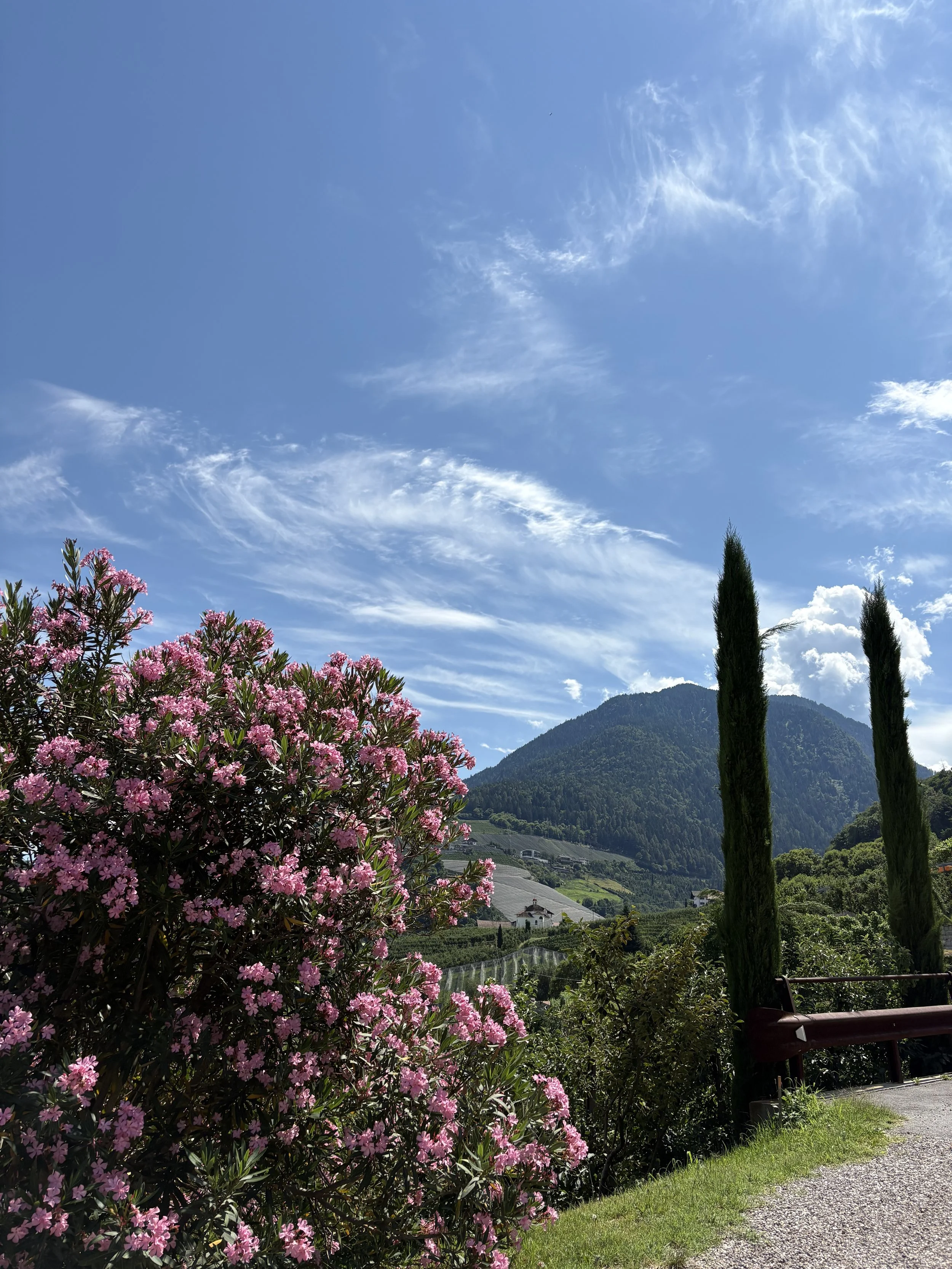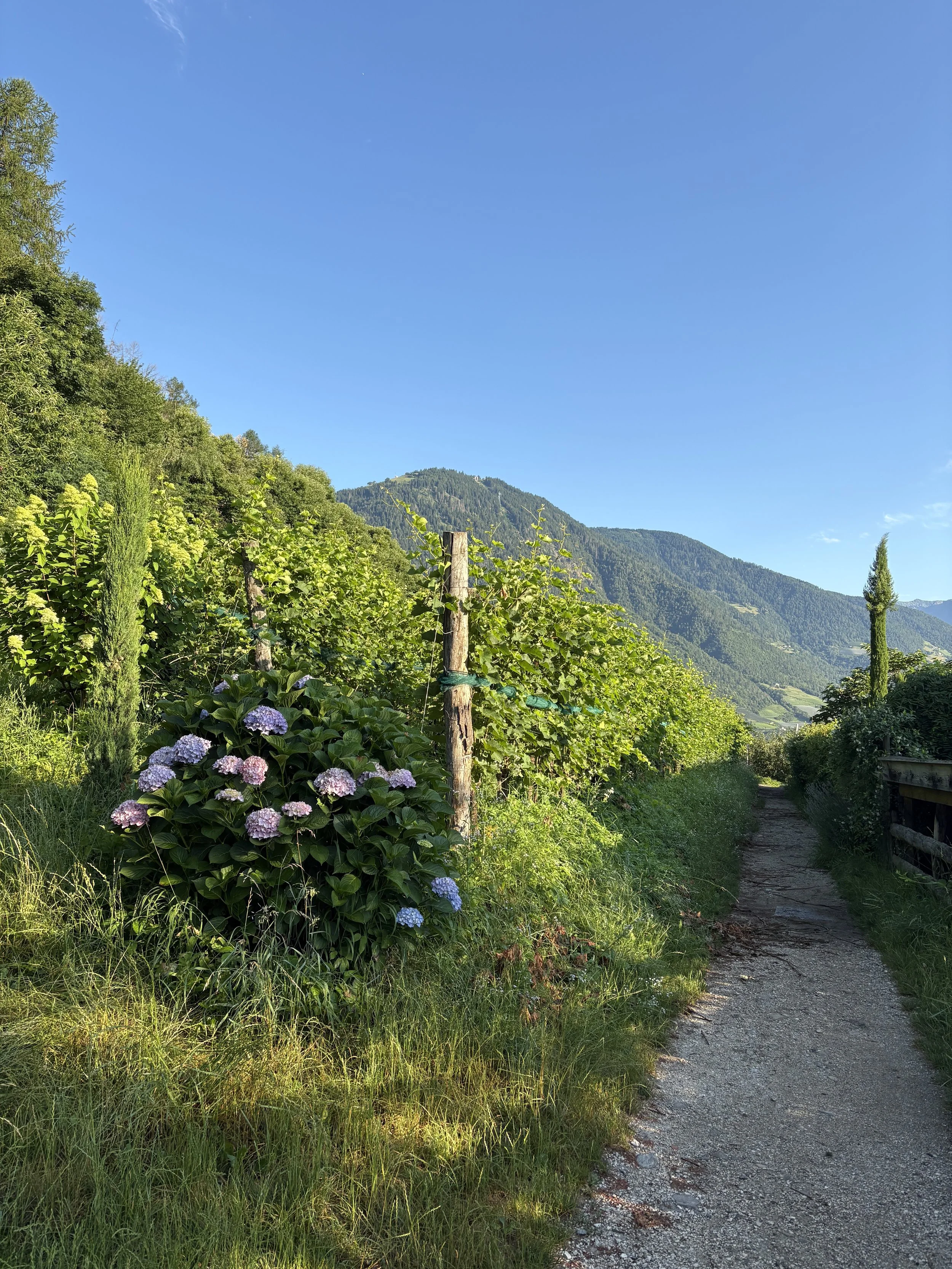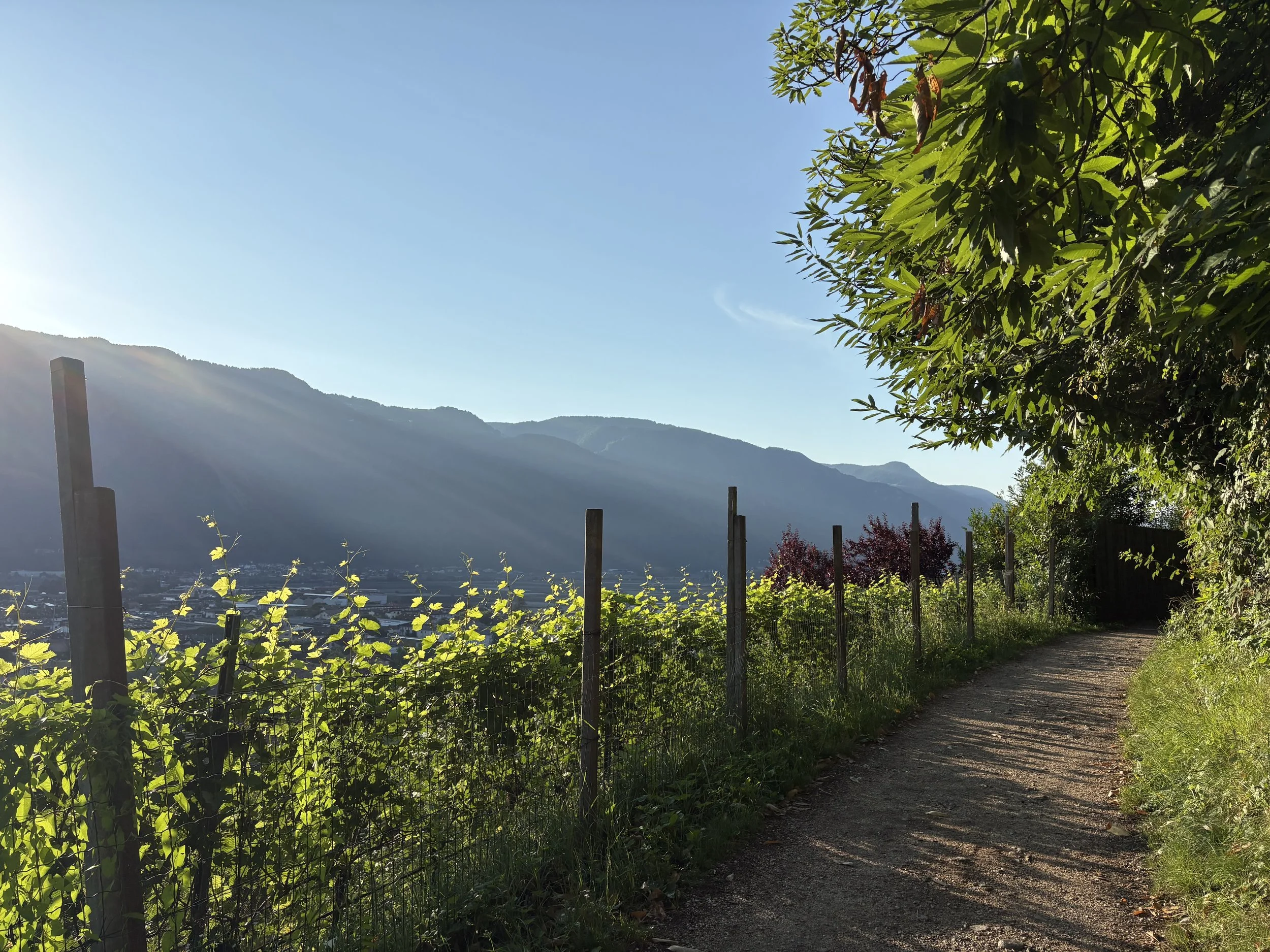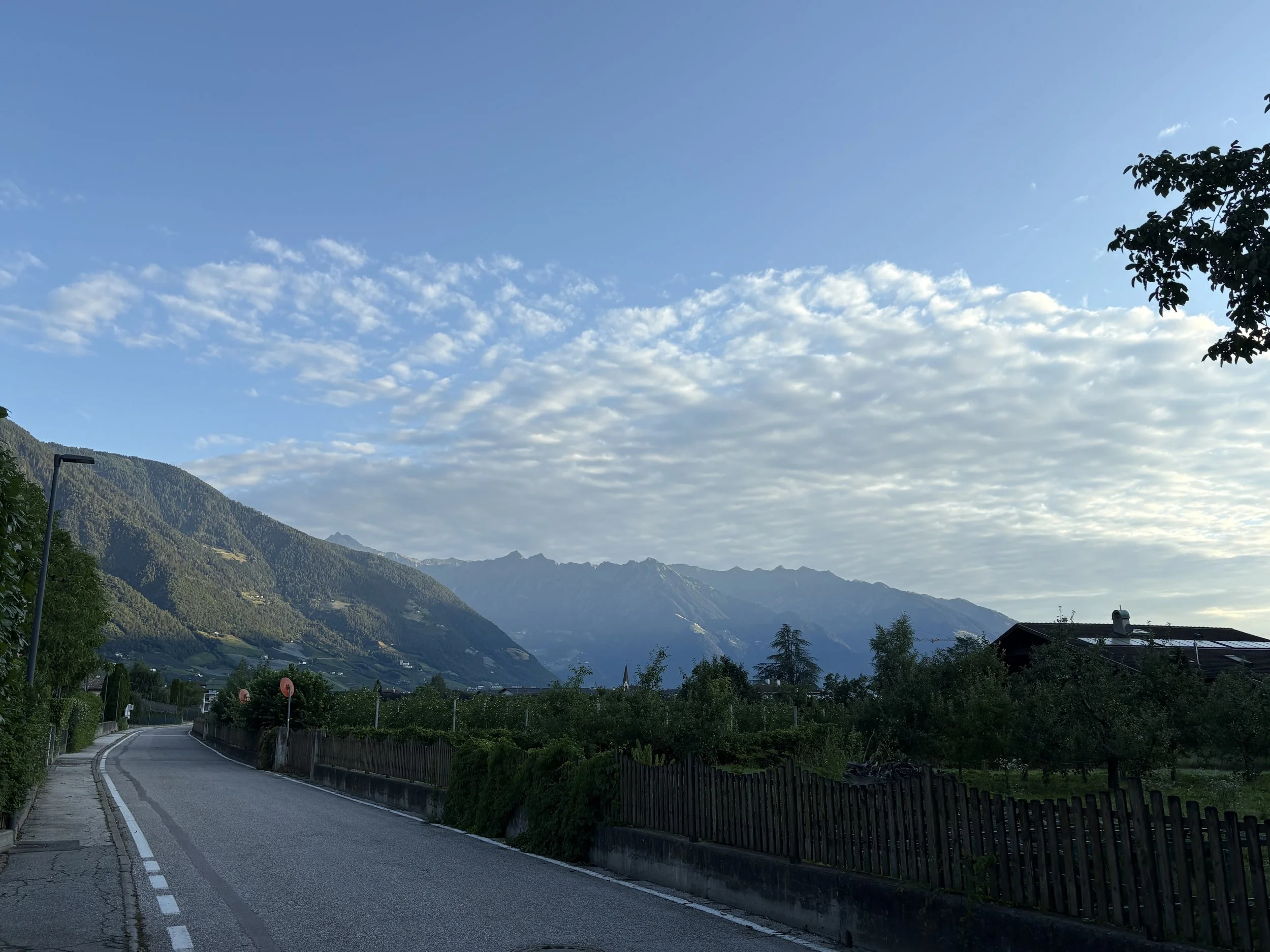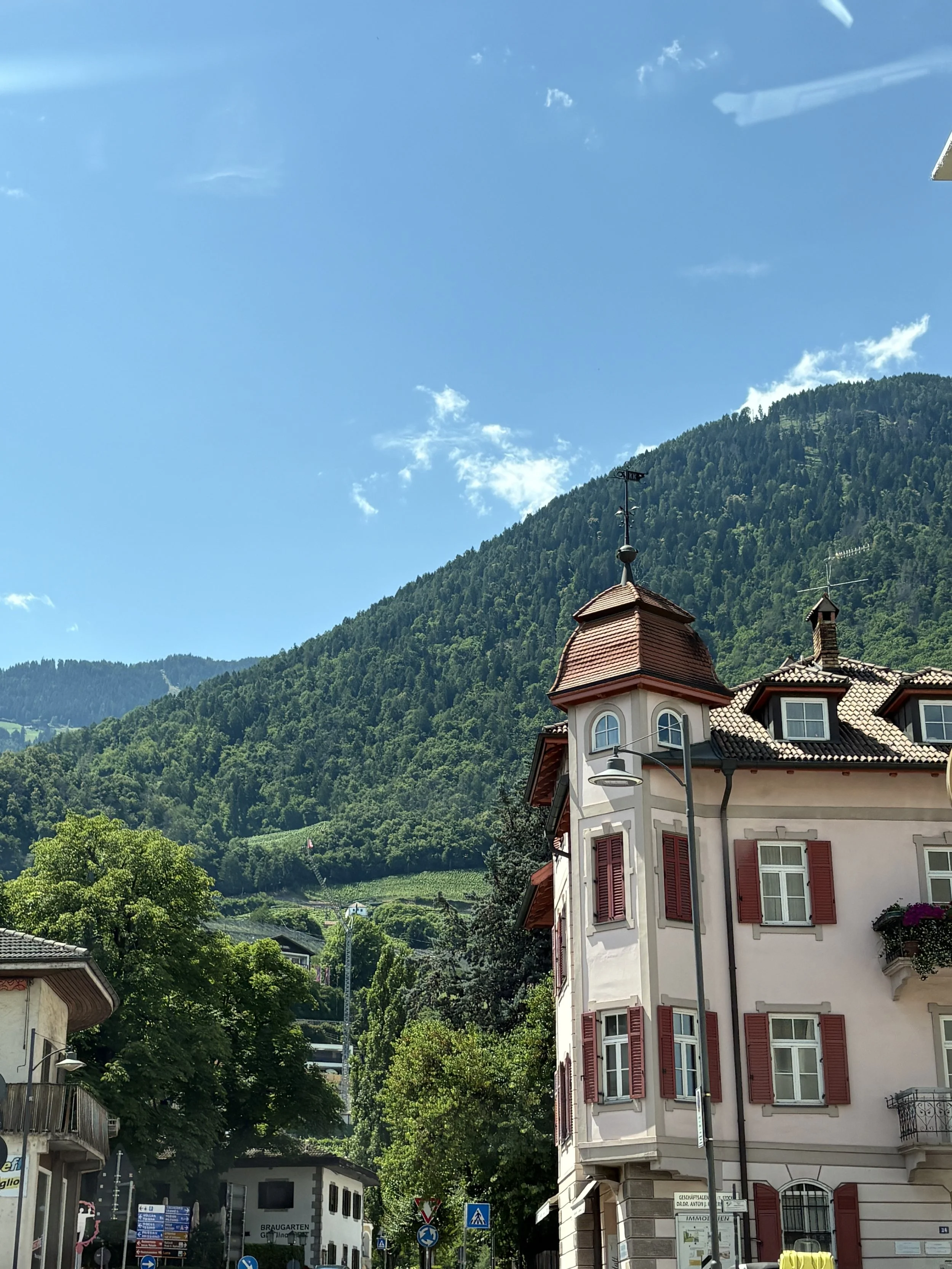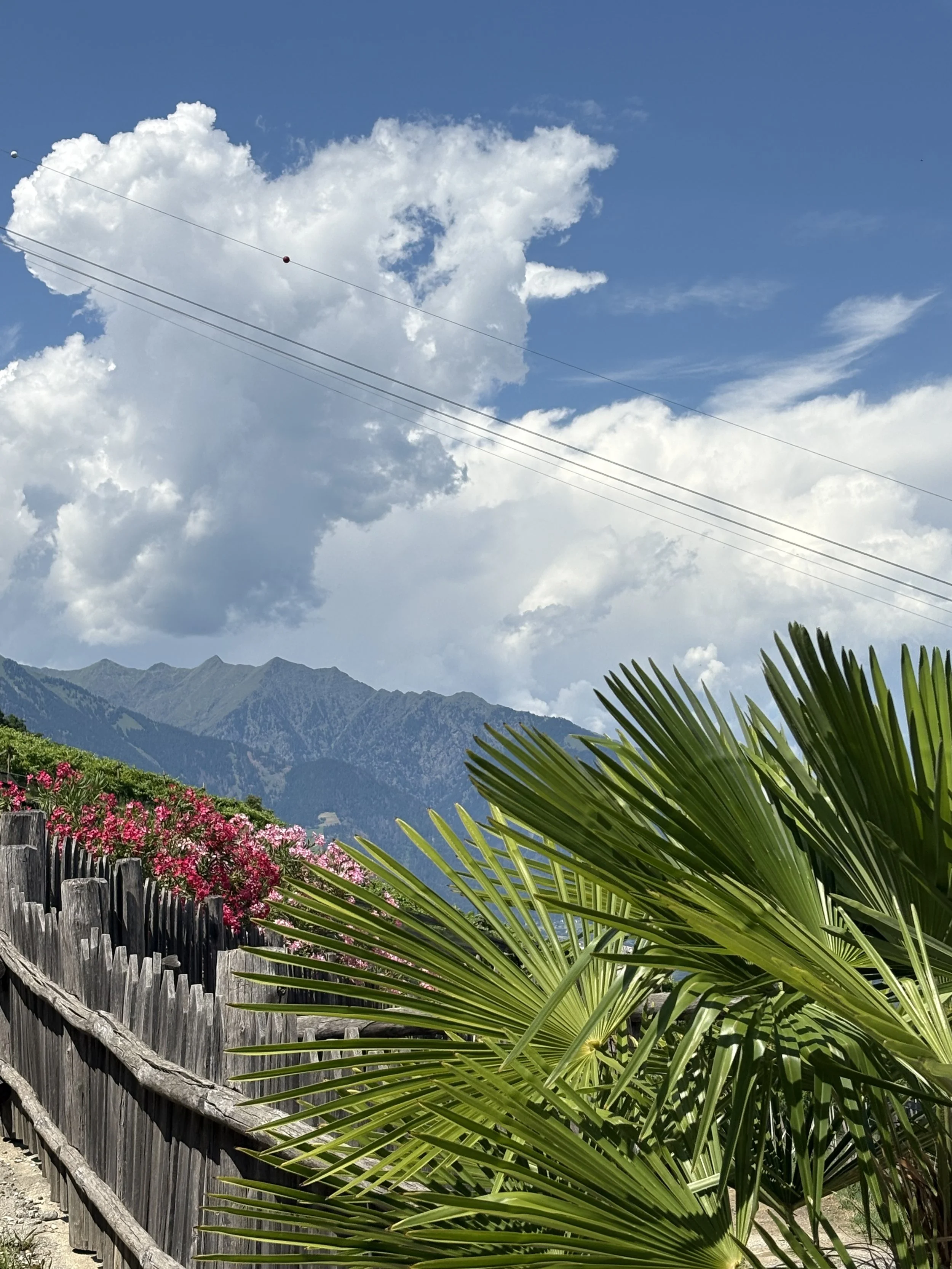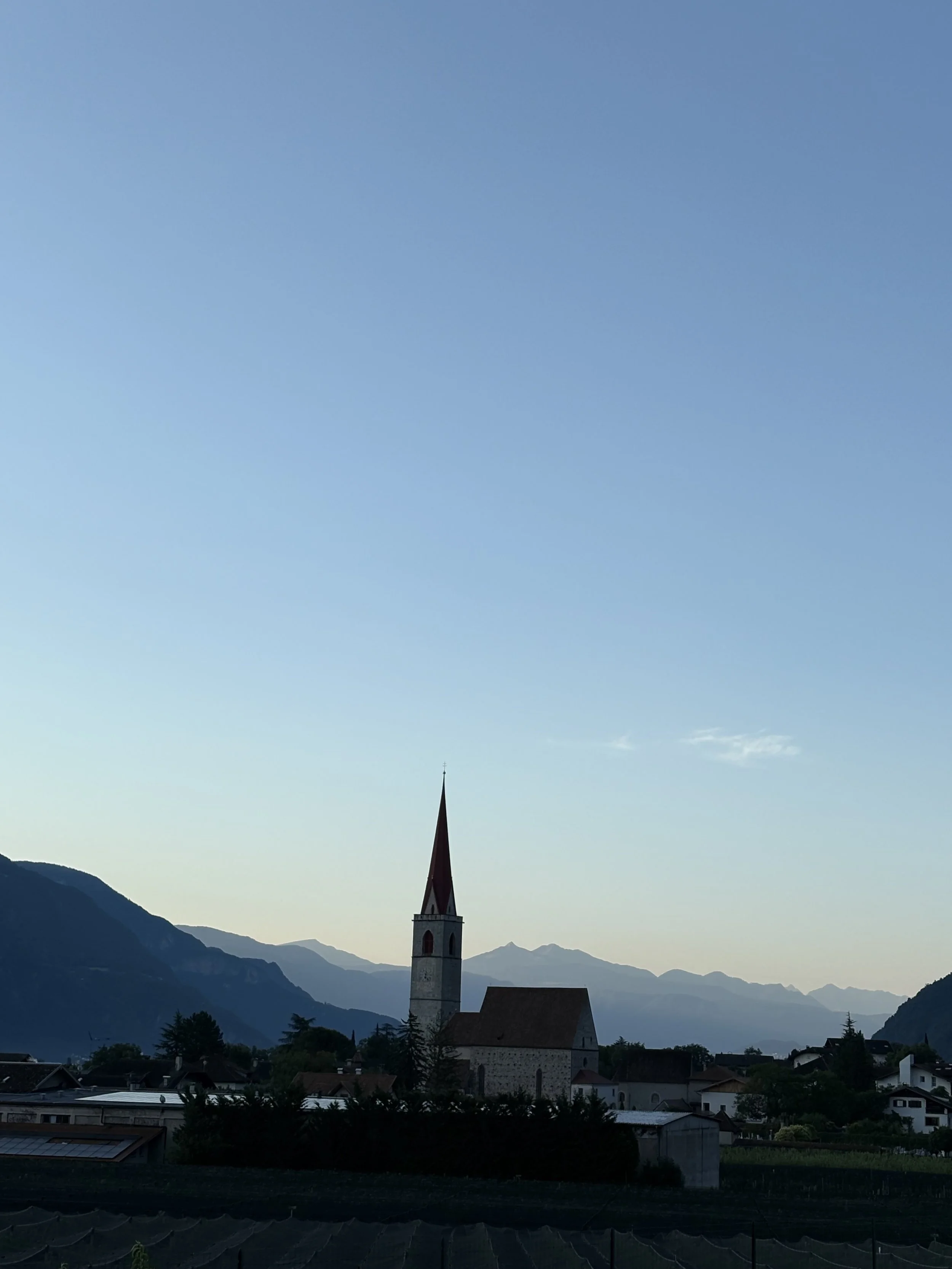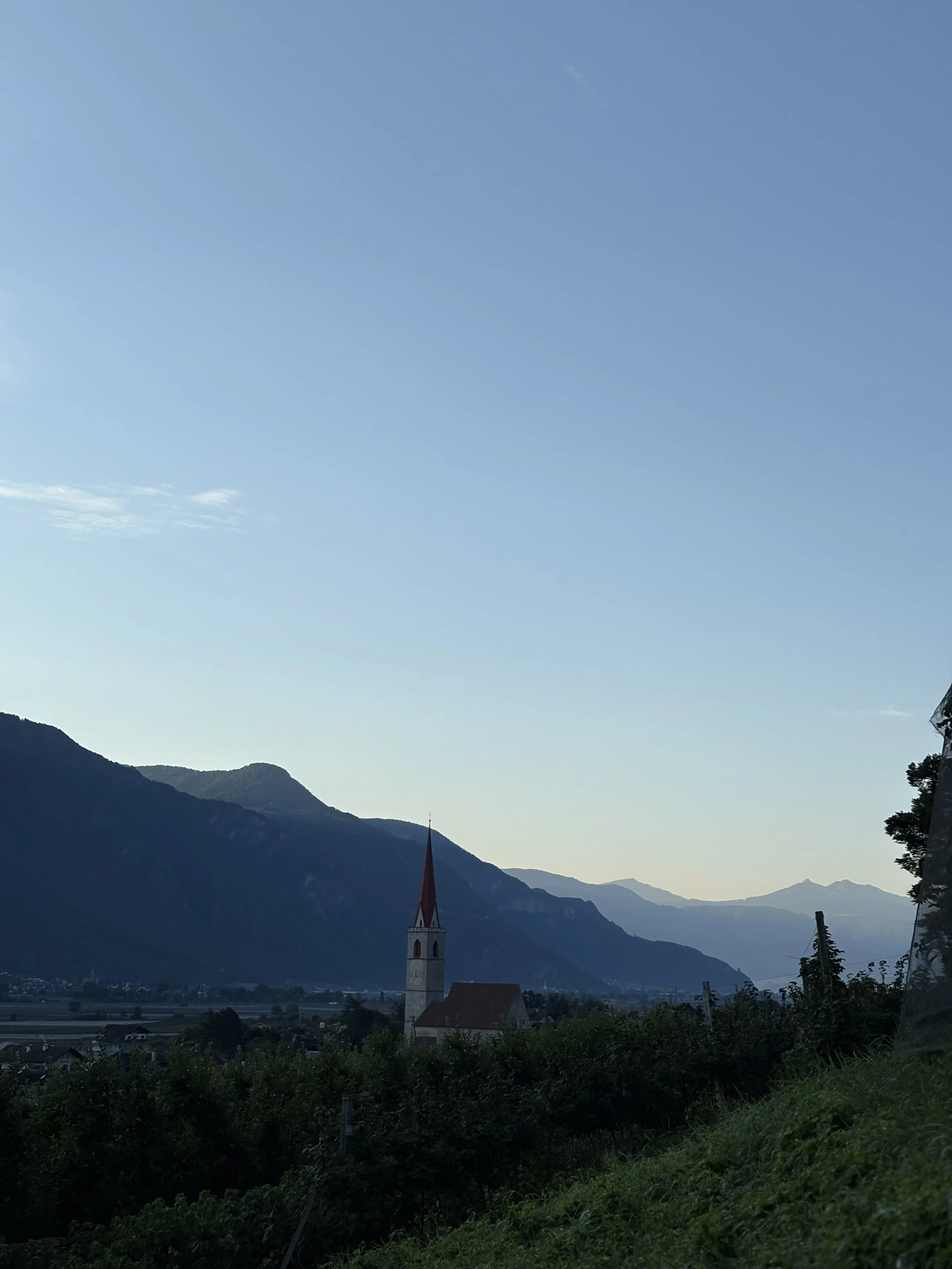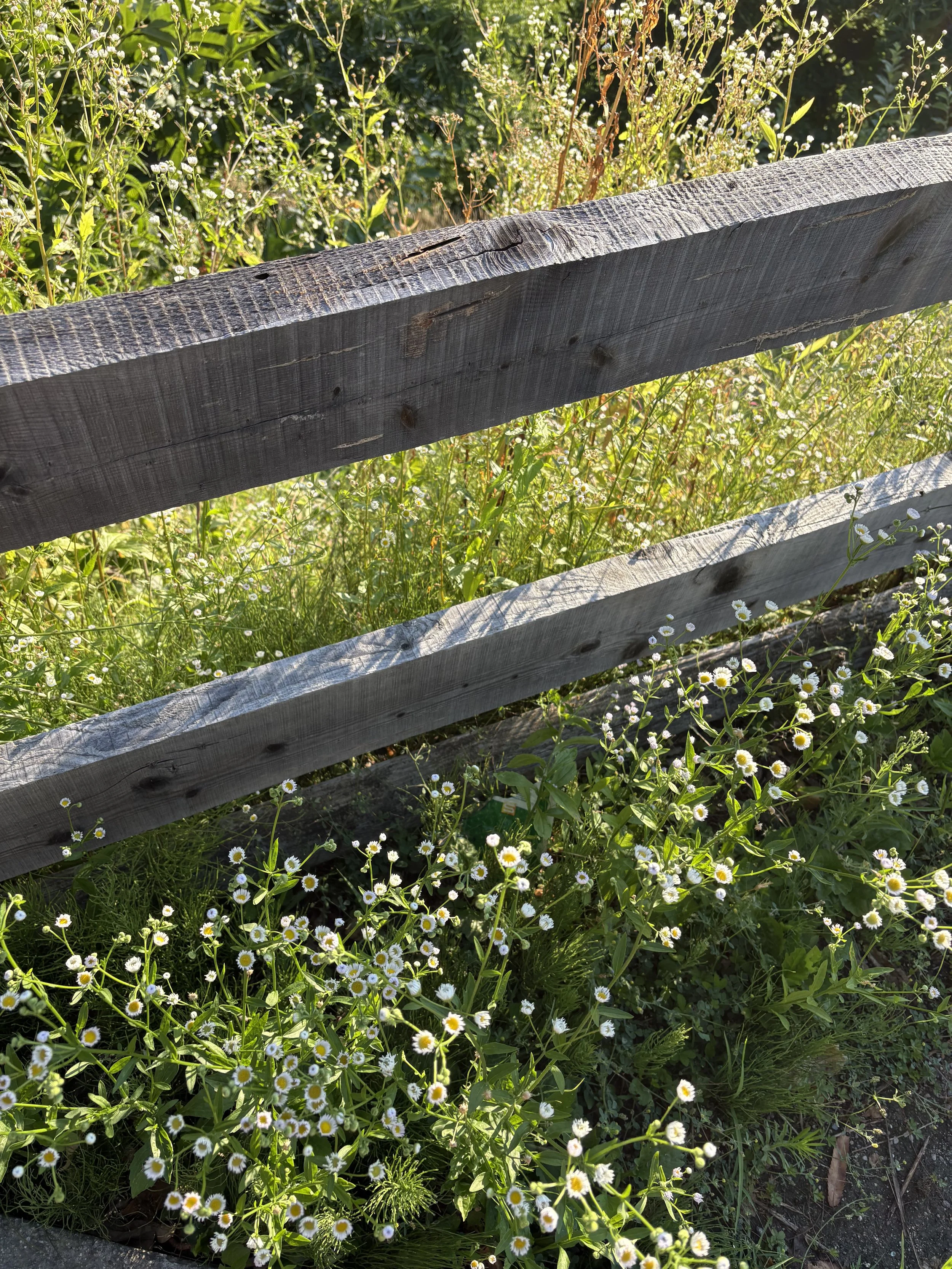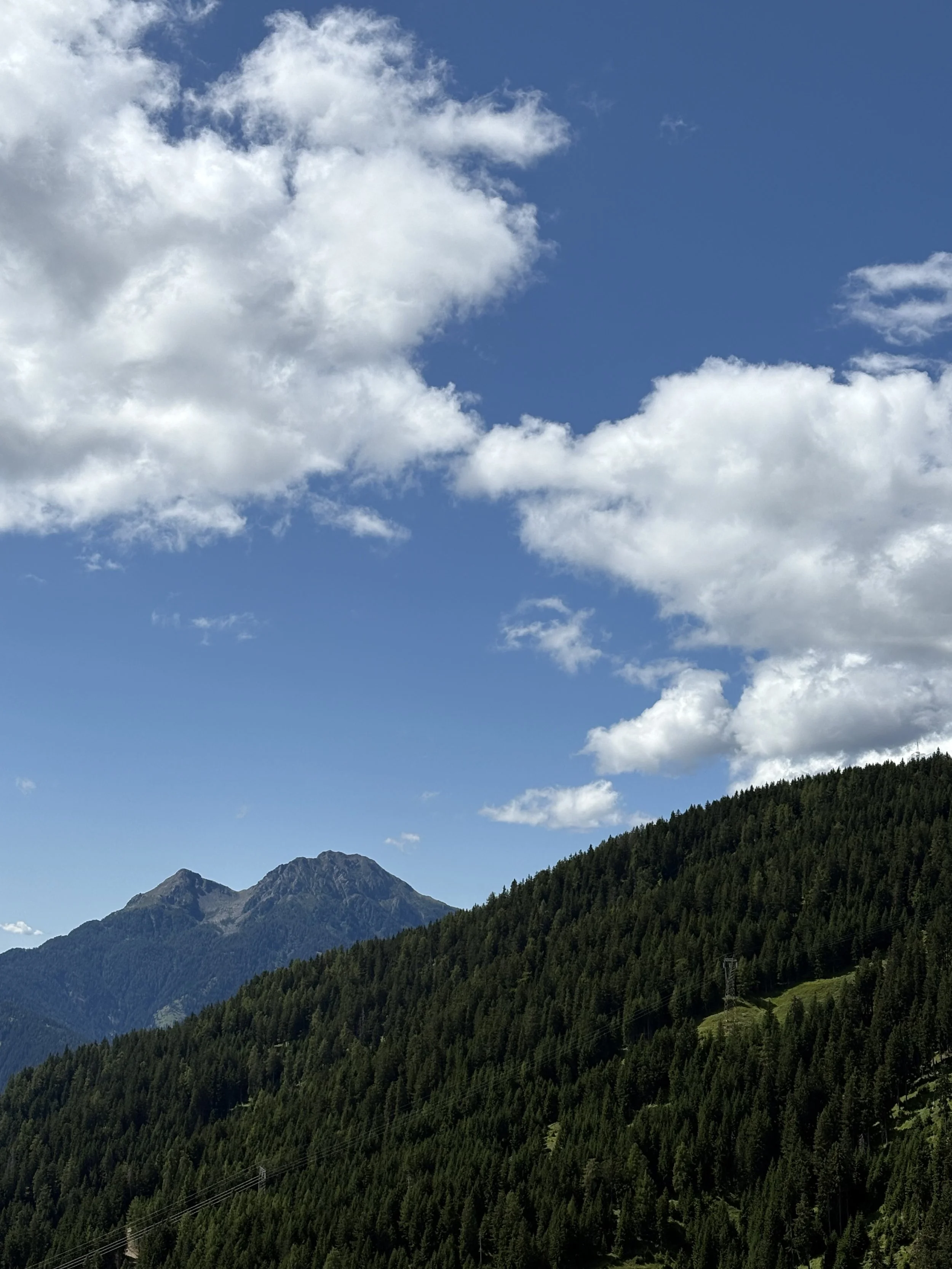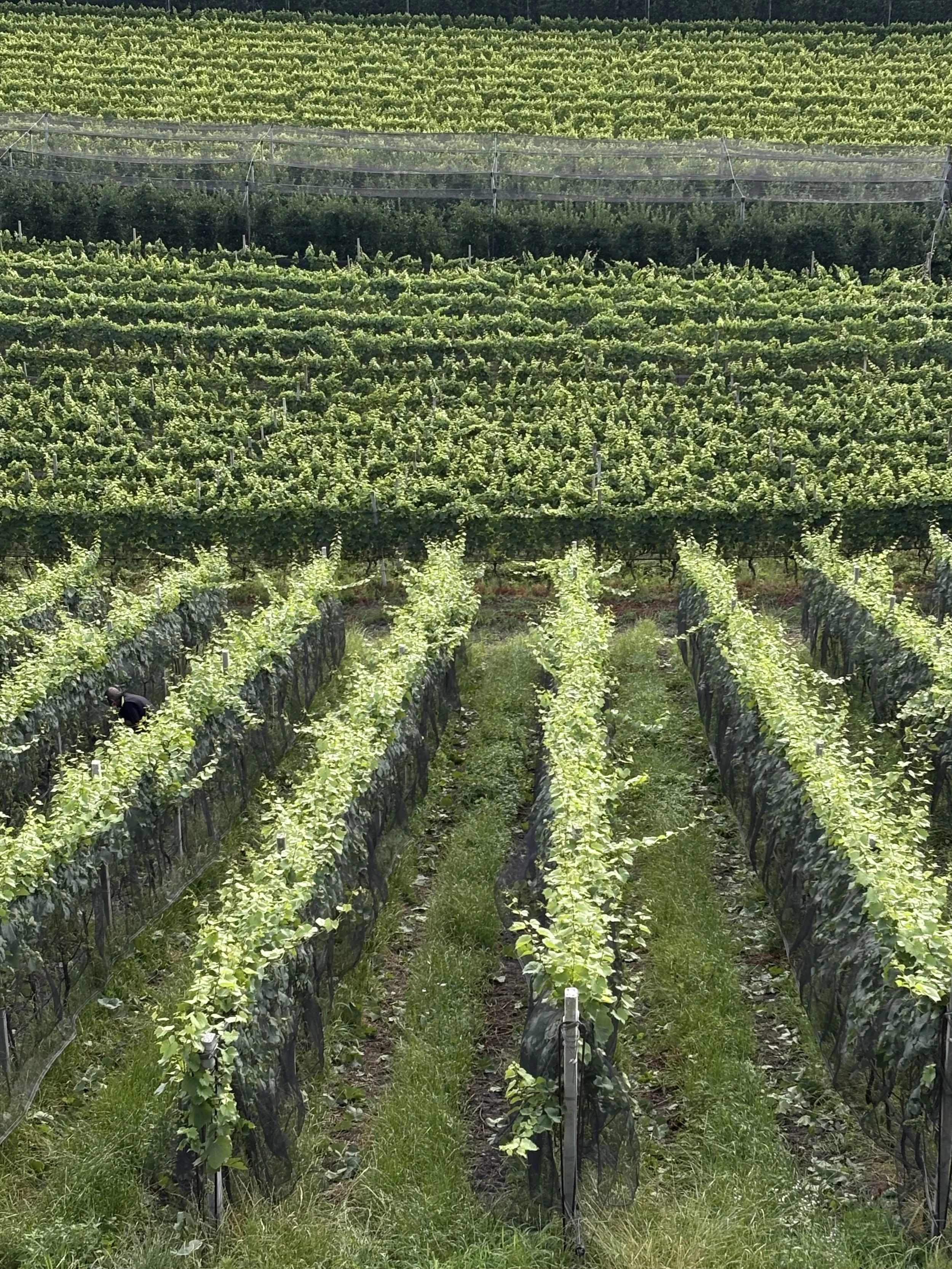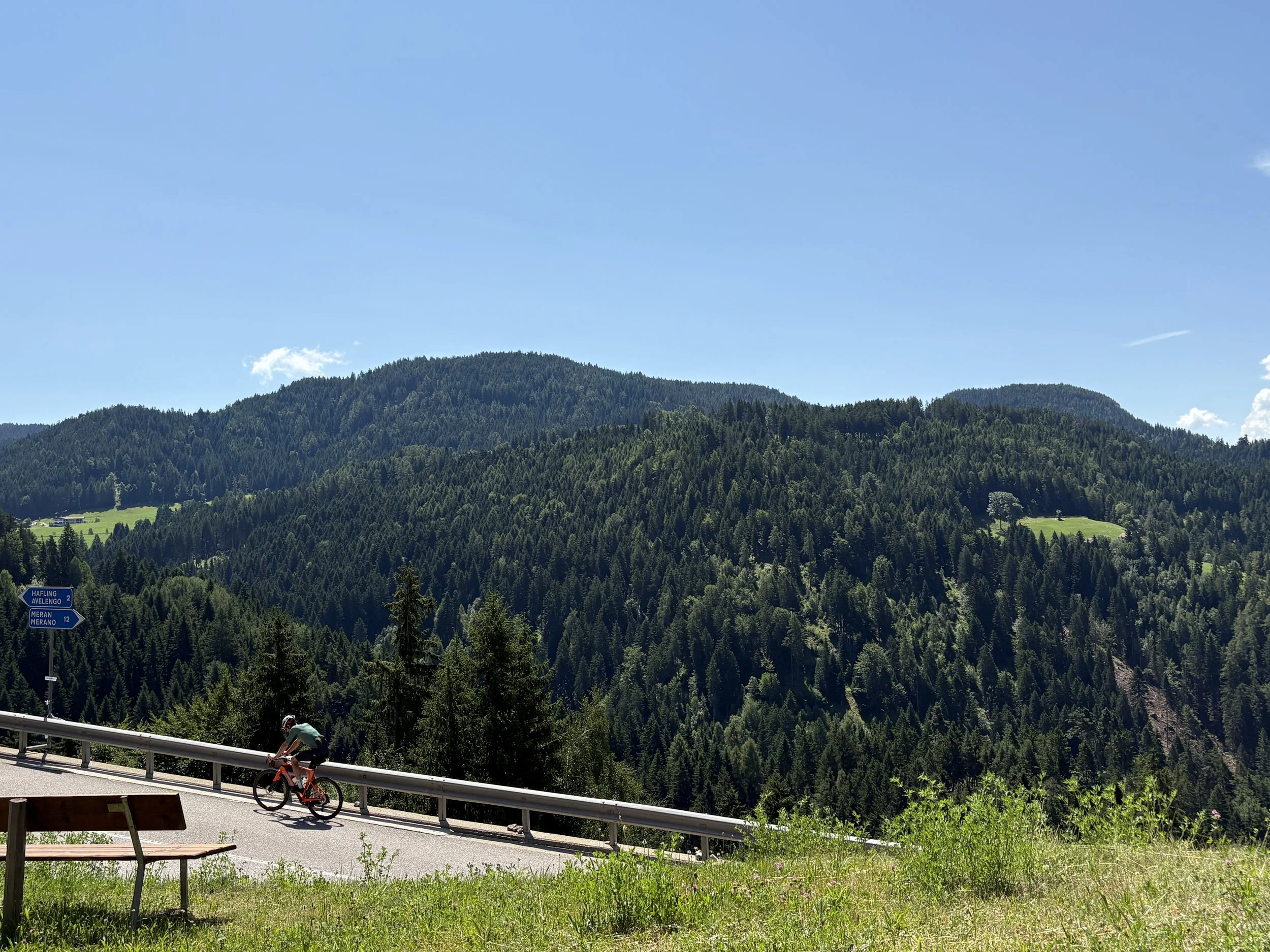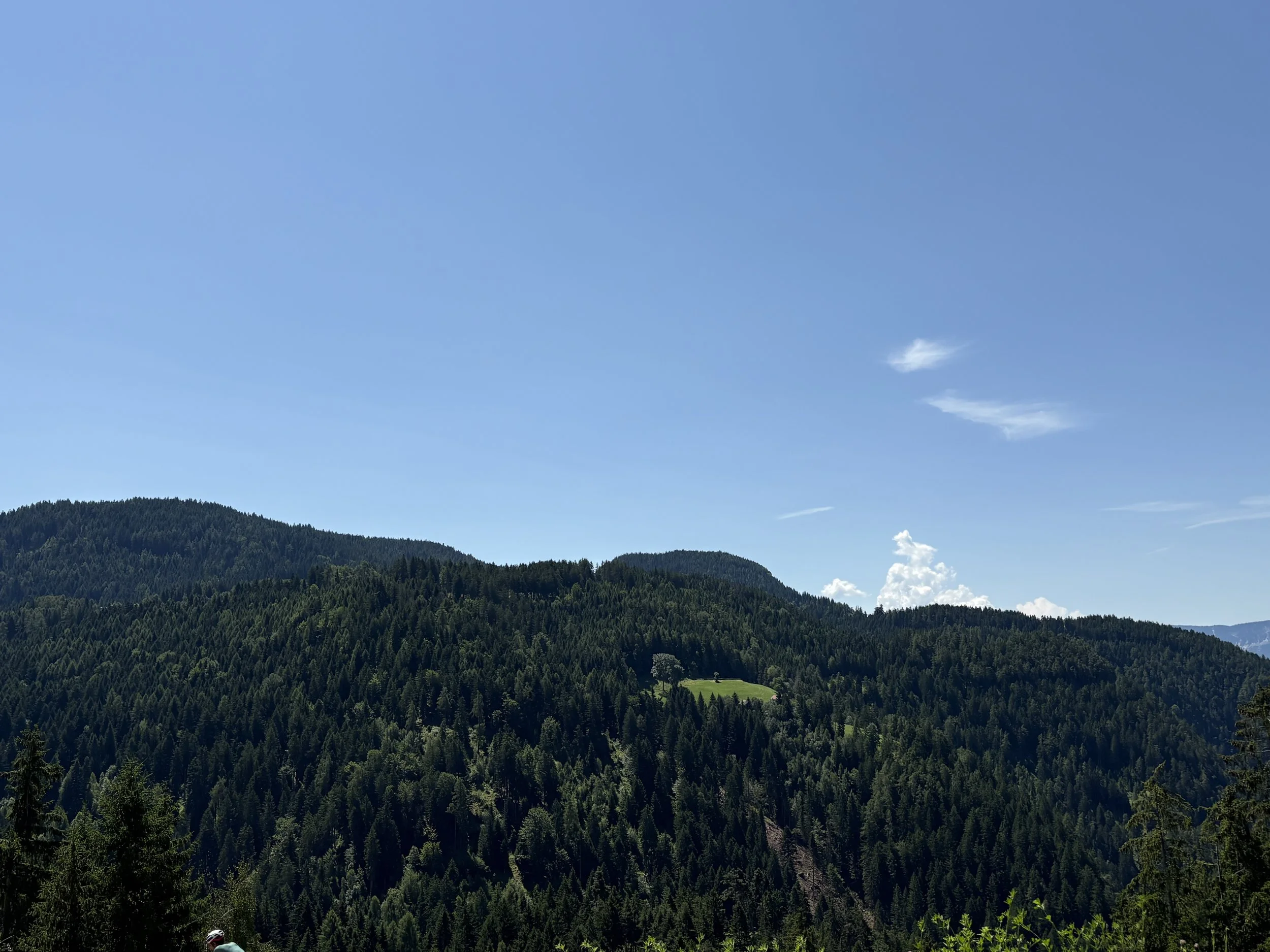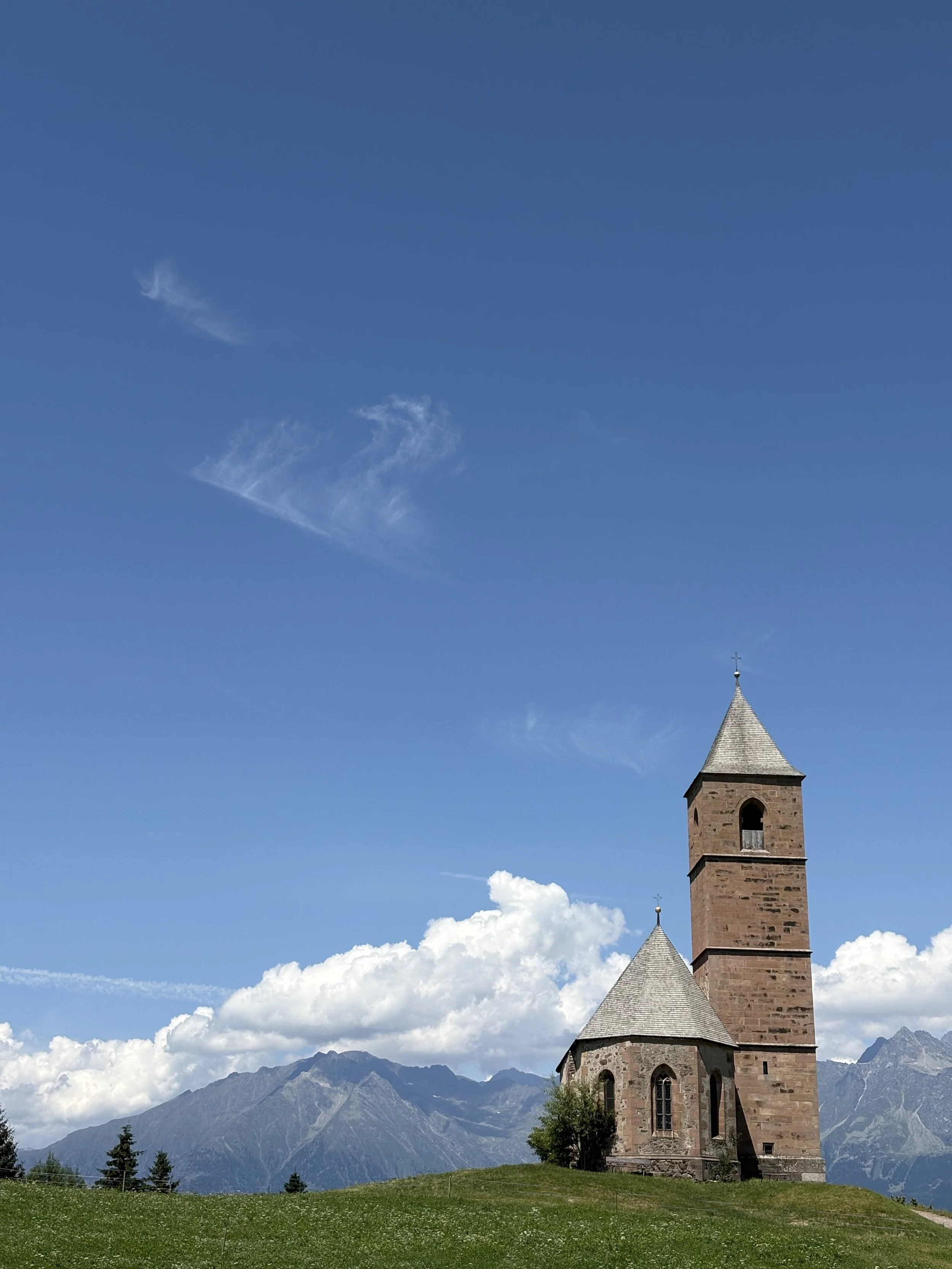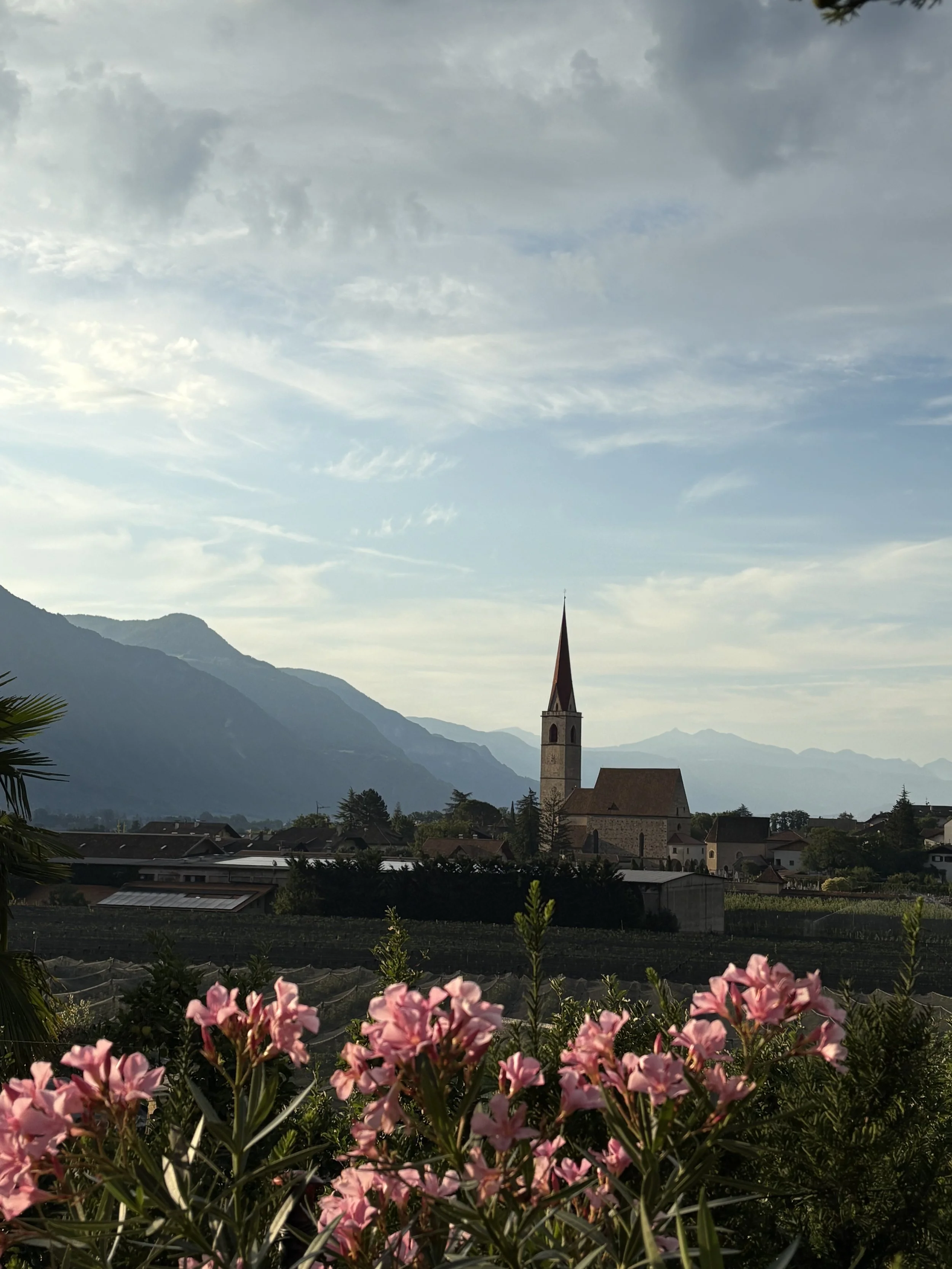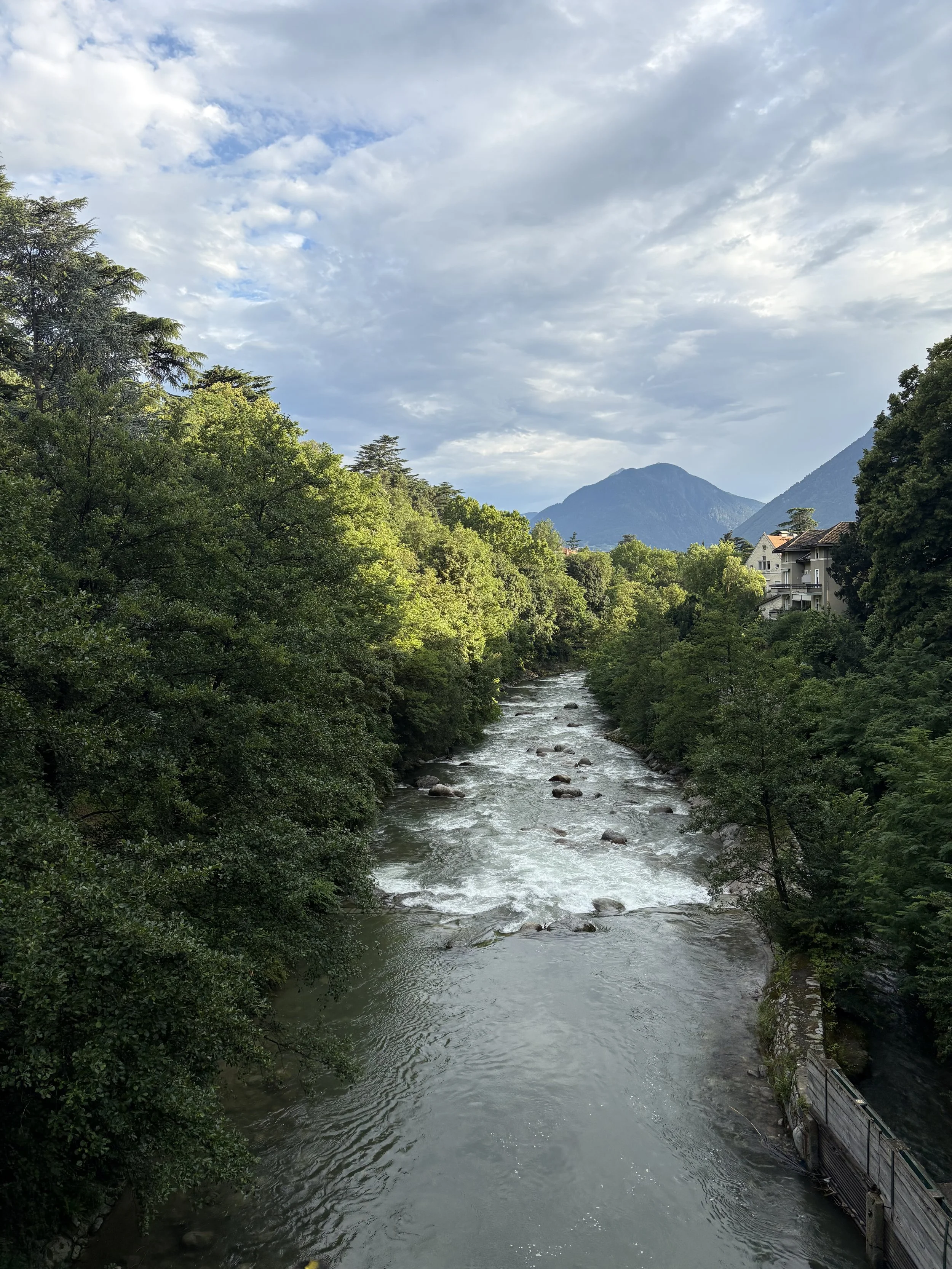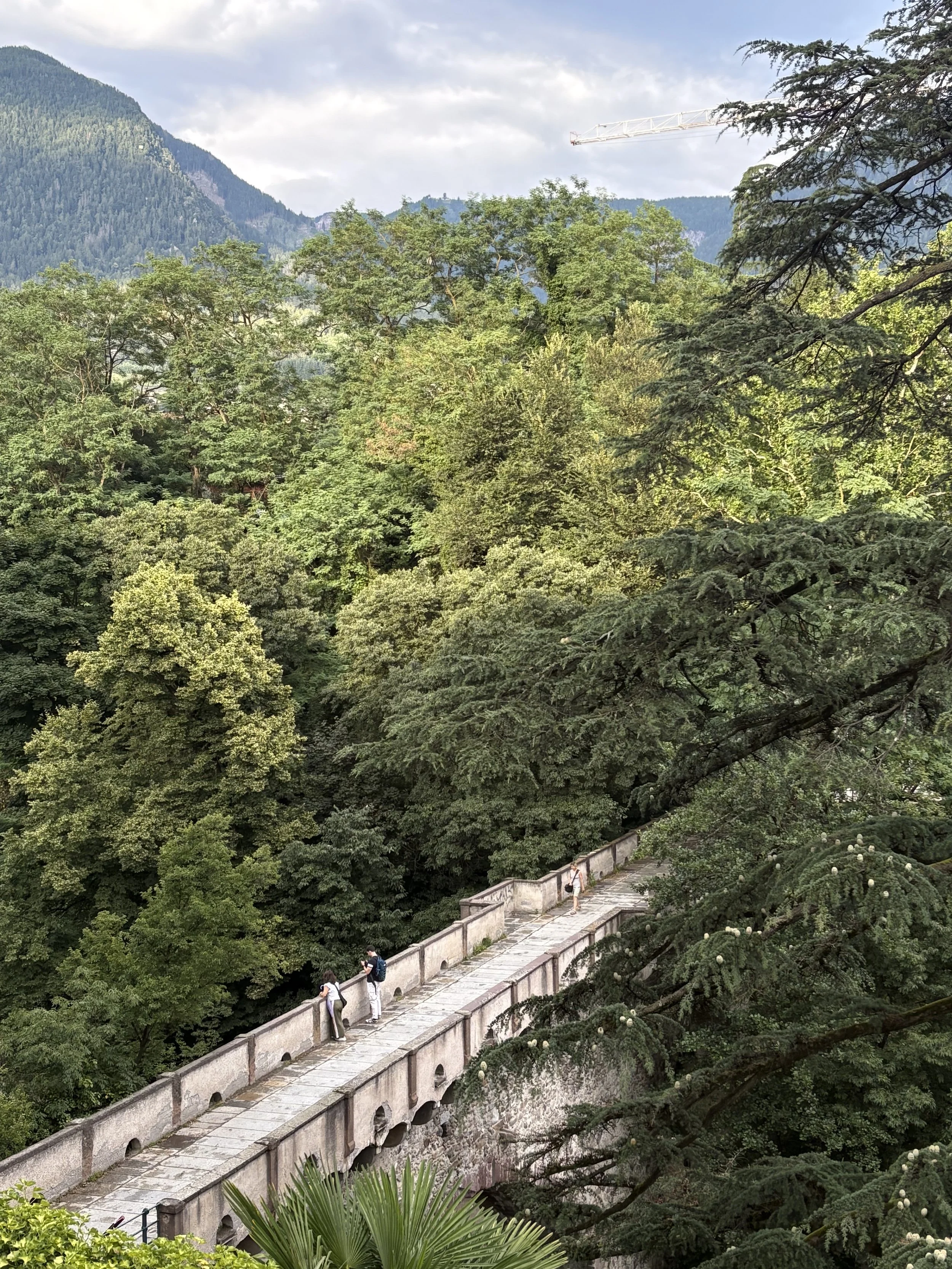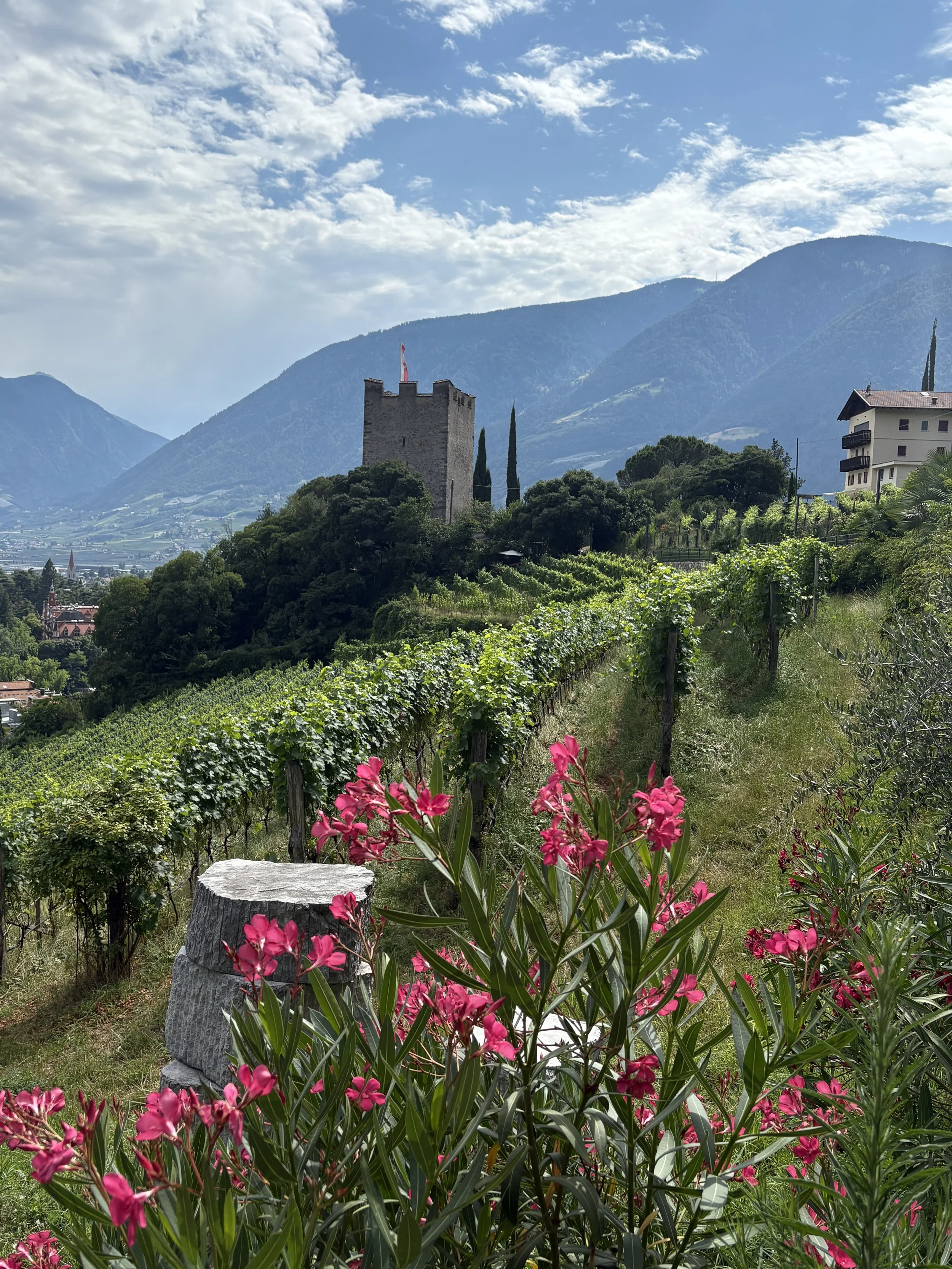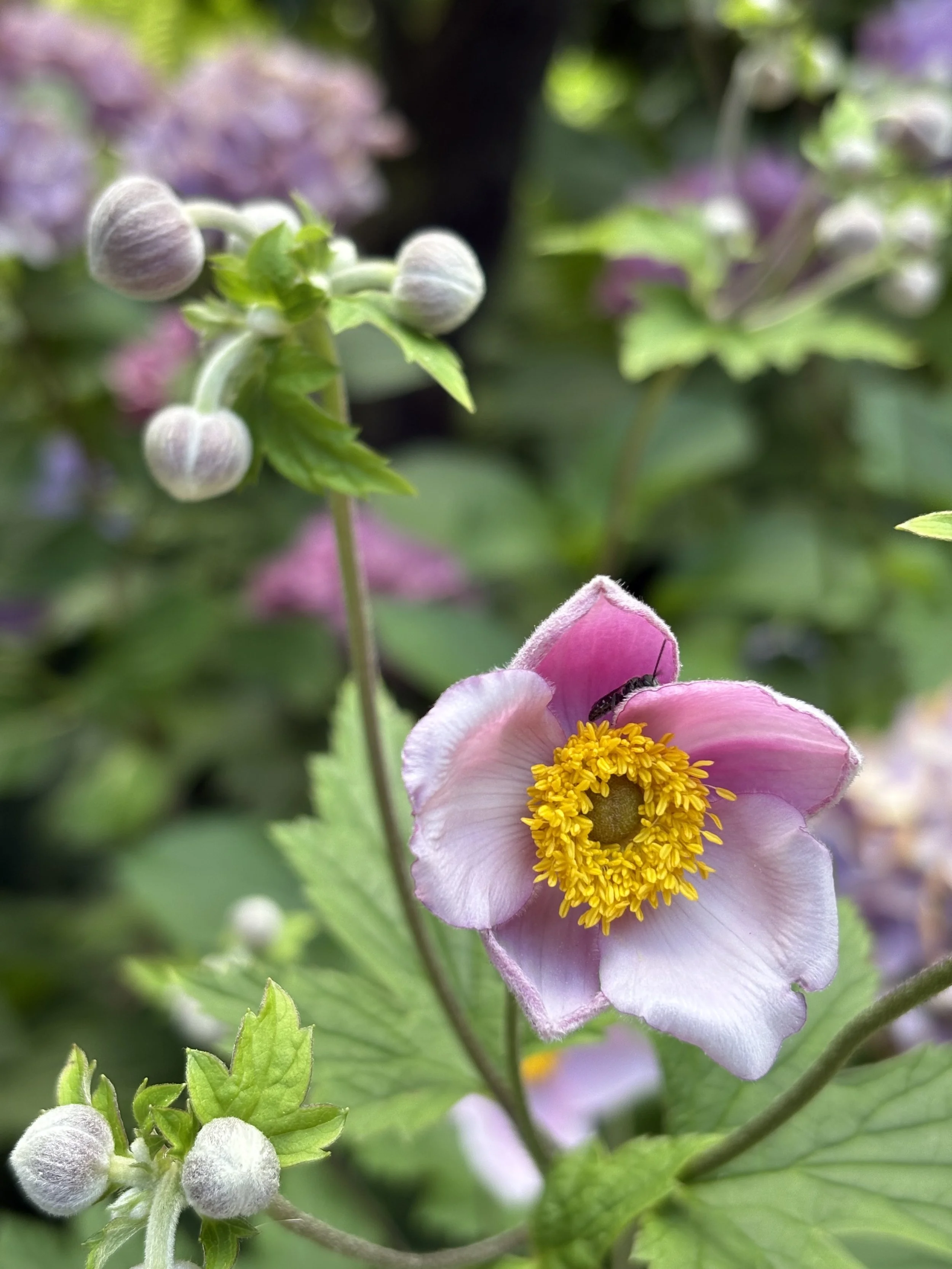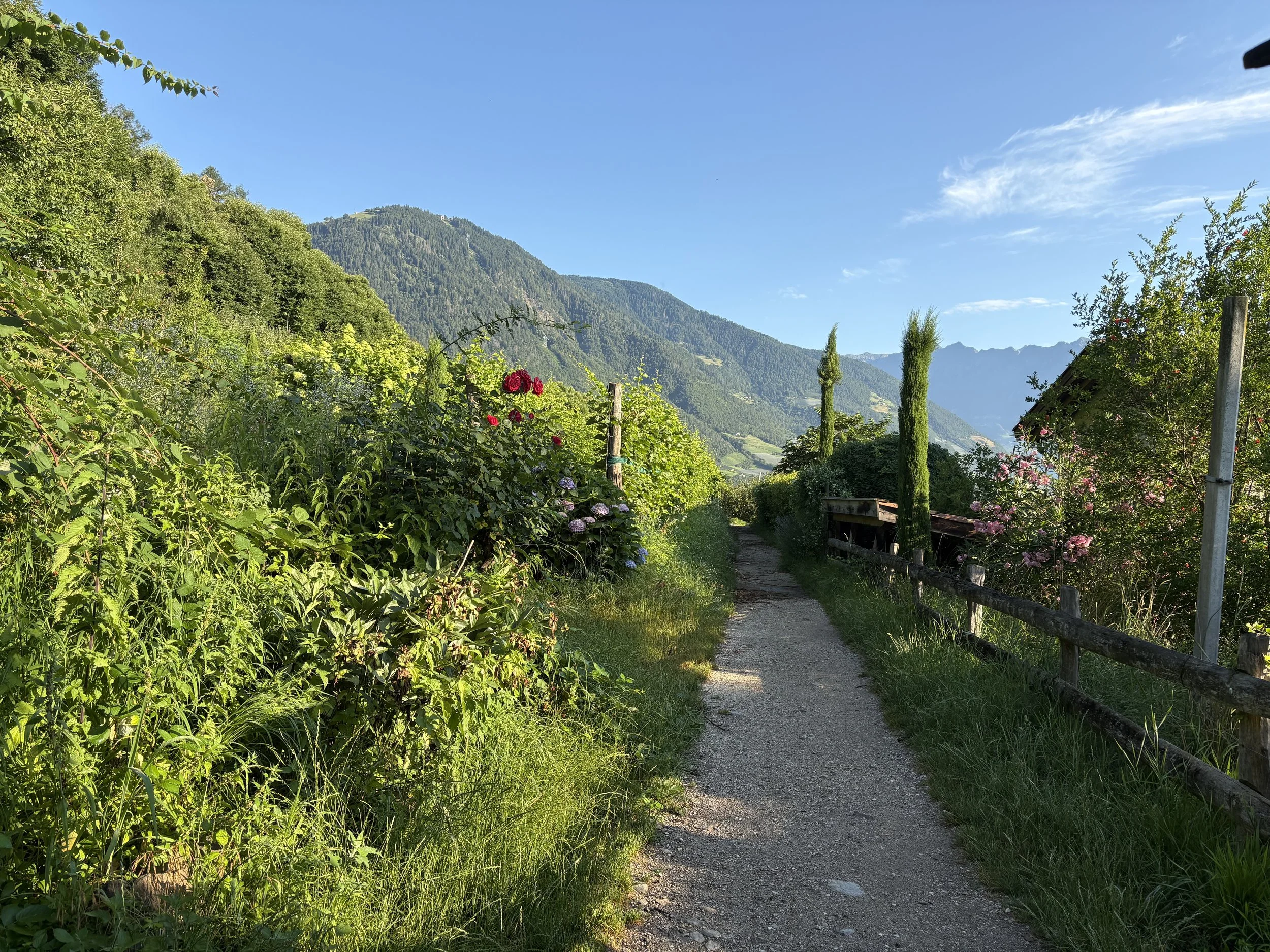Meadows of wildflowers. Mountains covered in alpines, with one narrow, barren route over which the chair lift runs, as if an eraser swiped it. Bees, endless bees.
I sit on a deep wood bench, the back as tall as my height. I might as well be sitting on Emerald City’s throne in The Wizard of Oz. I feel a little bit like a child; it’s one of those glorious moments that brings you right back. Bare knees face the blue sky, hands grasp ankles, and face tips toward the midday sun. It’s hot on the mountain, hotter than you think it would be 1,500m above the sea, and my forehead is warm within seconds. Freckles form on the bridge of my nose and trickle onto my cheeks. My inner adult tells me to go inside and reapply SPF and find a hat, another voice says… f*** it. I want to hear the sound of sweet vernal grass in the breeze. I want to count the lavender, bright yellow, and white strokes that dot the meadow, leading… leading nowhere. And everywhere.
Nature has that effect, doesn’t it? It is both everything, in the sense that there is nothing greater or more immense, and then it is a blank, like an open and inviting expanse of Reset, allowing us to shed everything and settle into its rhythm. I think of a French press. We spoon in the coffee grinds—all of our thoughts. We fill it with water, nature. And we let it seep. In a few minutes, we pull up the handle, and, voila, everything is the right consistency.
At this height on Vigilius, all is smooth. We are literally above the grinds. I hear Black Redstarts and Robins and Chiffchaffs. There are Mistle Thrushes and Ravens and Water Pipits. They sail above alpine poppies, edelweiss, and buttercups. Vanilla orchids and anemones lift their chins to them, then sway left to right in the slow mountain breeze.
Stillness in motion. To sit on those warm slats of wood and be present for this theatre is a memory in itself.
Inhale deeply.
Don’t exhale :)
We are in…
Germany. Or Austria. Switzerland?
It’s technically Italy, but if you go by the license plates, the language, the food, and the quality of the roads (immaculate) it’s definitely not.
The last time I visited Alto Adige was 2018. I arrived in early October by myself, without a car, hiking boots, and the slightest amount of context. I was ignorantly unaware that crisp October is a non-season. (Autumn leaves? Cosy evenings? Perfect temperatures and less crowds? No?) The summer season had ended, and the places starred on my Google Map were taking a much-needed rest. I may have been the only one in San Cassiano, a tiny town at the northern edge of Trentino-Alto Adige. The only living thing I spoke to that whole trip was a cow.
Quite a few, actually.
Nevertheless, and maybe actually as cause and effect, it was one of my favourite trips. I spent the next few years telling people how much I loved the Dolomites (as ignorant as I remained thus afterwards). I walked endlessly and breathed in mountain air so pure, I felt I had been drugged. The scent of freshly cut wood drifted under my nose at every turn, and gentle breezes skated through leaves as water rushed beneath footbridges. Some may refer to the cumulative effect as valium, distilled. I knew nothing about South Tyrol, nor the different sub-regions, nor the vastly varying vegetation from one mountain range to another, nor that German remained the first language.
I suppose ‘Moo’ varies not, as far as linguistics are concerned.
Fast forward to this past June, when I opened up the entire map of Italy on Airbnb and searched for somewhere clean and inviting. My wishlist was simple: somewhere outside of a sweltering city where I could work remotely, go for a nice walk, and not grow annoyed by masses of summer tourists.
From City to Linate. 90 minutes. A breeze. From the Sixt rental car desk to the car itself, to figuring out how the air con works, about 8 hours.
One suggestion for all trips, especially when you’ll be doing loads of driving: rent a car that you would like to drive. Rent a car that responds smartly when you are winding down a mountain with sharp hairpin turns. Rent one with a charging system that does not require a cord. Rent a comfy one. Rent one in which you will feel like a million bucks when you go for an evening drive, surrounded by mountains on all sides, glowing in the summer sunset, with the windows down and vineyards skimming by the windows. What is simple summer joyousness if not that? (It’s many things, but that is one of them, isn’t it?)
So I drove, from Linate to Lana. I made just one whoops: at the first toll booth, I did indeed (wincing) leave my credit card in the machine and drive away.
On every trip, there is a blunder, isn’t there? (Months later I realised it was in the back of my wallet… this girl cannot multi-task)
I arrived in Lana. The view from the kitchen table, ie my desk, is verdant and covered in vineyards, apple orchards, and an alpine home here and there. Further up, dense forests adhere to the mountain like Velcro.
Now here come the facts that I’ve only just taken the time to look up, on my last (for now) night in Lana. Because I am the type of person who reads the true story after seeing the movie.
Forests cover nearly 50% of South Tyrol.
(I’ll drip these in, not to overload you, though I do love a fact).
Driving in, after you exit the autostrada, or autobahn, you might ask yourself: Is this the most idyllic mountain town?
It’s heavily planted—every traffic circle is boisterous with brightly coloured flowers. People at crosswalks smile widely and say thank you. In fact, everyone is smiling, much of the time. Julie Andrews does have that effect on people, doesn’t she…
Alpine buildings the colours of wildflowers line the main road; greens, light pinks, oranges, and whites against a bright blue sky are utter cheer. Boughs of oleander mushroom onto the sidewalks between chestnut trees. On side streets, I find anemones, a delicate tree with a drab name (crapemyrtle), Rose of Sharon, and sunflowers that rise high like overeager students. Wayfaring trees line narrow pathways along rushing water, Sweet Chestnuts sprout furry little fluorescent buds that blow my mind, and kiwis grow by the hundreds on arbours over my head. But, I shall return to the fruit, because that in itself is a sensation I can’t yet translate to paper. Effort must be made, however.
I am, as most are, easily enchanted by Novelty. I fall in love with beauty, and all is roses (or kiwis), and then a few days go by, and I think, ‘ah, bene, I think I’m done here.’ But no, not in Lana. Not in this area of Alto Adige. Not in this nook of verdant idyll, on the shirt sleeve of the Austrian state of Tyrol.
Now, let us situate ourselves with a little history/geography lesson, because I did not know any of this, and it is fascinating and illuminating all at once. You say to yourself, Oh there are mountains, and we say ‘Morgen’ instead of Buongiorno and license plates are marked with a D for Deutschland. All of the products and road signs are in German, the architecture is unmistakably Alpine, and literally no one is speaking Italian. You think: ‘Oh isn’t that charming? I thought we were in Italy, but oh well.’
South Tyrol was part of the Austro-Hungarian empire until the end of WWI. During WWII, Hitler and Mussolini had many a talk about this region. In fact, even until 1992, South Tyrol was negotiating the terms of its identity. Today, South Tyrol is nearly autonomous. It retains most of its taxes. It governs much of its own affairs. And while technically part of Italy, it doesn’t feel like Italy. It is, factually so, as evidenced by the excellent espresso, but it’s not, in that when I speak Italian, I am showing my hand as the odd foreigner.
For those who think in maps: it’s about 30km from Lana to the Brenner Pass at the Austrian border. I wonder, why are there German plates and not Austrian, but I suppose Austrians have plenty of Alpine towns to choose from?
I am here to work remotely, but I have balanced my time with a solid dose of Outdoors, of which I am profusely fond. If you know me, you know that all it takes to light me up is a stroll through one of London’s glorious parks, or a run around Carmel, or a sunrise on Mt. Tam. Something about this place reminds me of Marin. There is that Northern California aesthetic—the dense forests, the winding, mountainous roads, the ubiquitous views, the air, the lack of pretence (and fashion), the fresh local produce, the cyclists, the hikers, the happy people, the peaks in your rearview mirror wherever you go. Indeed, if it weren’t for all the German, and the fairly-priced produce, one might mistake this for the California I used to call home.
Except, it’s not of course.
Words I have learned: Morgen! (every morning at the caffe, and every time I pass someone on a path, and every time I go to buy fruit in the ‘Morgen.’) Also ‘wanderweg’ which means ‘hiking trail.’ And my favourite words: Obst und Gemüse. (Fruit and vegetables— the most essential).
I rise just after 5am and open the door wide. Outside, the world is streaked with pastels. The mountains are waking; stretching their limbs and combing their hair. The sun hasn’t risen, but it’s that in-between hour, when it’s undeniably Daytime, yet peace still abounds. I make myself a strong cup of espresso blend (from Kuntrawant, outstanding coffee I will miss dearly) and sit on the terrace watching the peaks. Then I set out on a walk— flights of fancy in every direction. Some mornings I trace the town, edging around apple orchards, already enlivened with a moving tractor, or I walk the tightrope above the town on the Brandis Waalweg, from where I feel like I can touch the church steeple. At that hour, it appears painted onto the drapes of mountain silhouettes. Other mornings, I drive up to Tirolo, where I walk along orchards and Chardonnay vineyards toward the castle, the ancestral seat of the Counts of Tyrol. There are countless paths in Merano, or just about anywhere. This is Alto Adige; the land of Outdoors. If I were staying higher up on Vigilius, I would relish a sunrise walk 1500m above sea level, surrounded by wild flowers and whistling leaves. (We’ll get to you in greater detail, Vigilius).
What I find endlessly fascinating is the mix of alpine and Mediterranean vegetation. One July morning, I wake to see snow capping the distant peaks, and yet my car is parked next to a heaving oleander bush and a palm tree. Echinacea are very happy here. As is lavender. There are hydrangeas, like what I see in my native New England, and roses, and infinite fruit trees. On my walks through Lana, I stumble upon apricot trees, peach trees, plum trees, fig trees, pear trees, and, as mentioned, the most insane kiwi arbour I’ve ever seen. Two kiwis in London cost 5 pounds. I could save a great deal by flying to Bolzano, renting a car, driving to Lana, and plucking a bucket-full of kiwis from the Brandis Waalweg. If only we could somehow solve the car rental ordeal, I could manage this in one afternoon.
Upon the mountain, the wildflowers are endless. Large-leaved lupines in multi-hued pinks and violets shoot up from the depths of green bushes. Timothy grasses provide a playful foreground to the distant views. Yarrow covers almost everything. Spruce trees sport hues of green so rich you think your sunglasses are tricking you. And fireweed spurts up in bright pinks like a second grader in leggings doing a hand-stand in the grass.
I did not realise until I searched just how many hotels are in this area. It’s known, after all, as a hiking, biking, and skiing mecca, but also as a spa and wellness retreat. Merano has been a celebrated spa destination for centuries due to its unique climate and radon-rich thermal springs. European aristocracy, particularly in the 19th century, visited the area for injections of vitality and rejuvenation. Empress Sissi, after which ‘Sissi’s Path’ was named, made the destination particularly well-known. To take a walk along Merano’s Passer River, listening to the rushing water, is a meditation class in itself.
Which brings me to the water.
The water that runs from the taps, and every fountain that you spot on every block and every trail, might be some of the cleanest in all of Europe. Here is valium distilled even further. We shall call it Xanax, doing a brand activation partnership with Klonopin. It is heaven to turn on the tap and drink without abandon. After London frizz and calcified water, I thought I’d never see my soft, smooth hair again. Et voila, one just needs a dose of Lana.
Here is an interesting fact: only 3% of the Earth’s water is fresh water. Of that, a very small amount is drinkable. Yet in Merano and the surrounding area, there are thousands of springs, an abundance of deep alpine wells, and gravity-enhanced aqueducts that have served the community for centuries.
This isn’t your average filtered water. It’s glacial, mineral-rich, and pristinely clear. Locals call it ‘living water’, not to be poetic but because it’s naturally oxygenated, microbiologically pure, and untouched by treatment systems.
It makes sense, then, that wellness is the dominant theme for the region’s hotels. Take Lana’s most renowned property, Hotel Schwarzschmied, an oasis hidden behind a church, residential roads, and winding drives. It’s the town’s jewel and at the same time, a discreet part of the community. This is, however, part of the South Tyrolian culture, I quickly learned. It’s not a region that shouts. These are a people of graciousness, humility, and quiet hospitality. The culture is elegance on low volume, artistry without self-advertisement, comfort and class without pretence. Hotel Schwarzschmeid feels like a cool, grown-up version of a hotel that understands luxury but still wants guests to feel at home. The gorgeous coffee table books on niche subjects are plentiful, the stacks of design and entrepreneurial magazines are abundant, and there are sold-out yoga classes every day. The spa program offers treatments that one doesn’t usually see, and there is an undercurrent of modern artistry and forward-thinking in its approach. The gym equipment appears custom-made to match the light wood, the architecture is thoughtful and minimal, and the landscape design surrounding the pool is at once dreamy, elegant, and whimsical.
Adjacent to Hotel Schwarzschmied is Villa Arnica, the funky sister hotel that doesn’t allow children. Here you will find artists in residence and yoga in a glass house next to an enormous orto surrounded by mountains. The environment is light, playful, and cheerful, full of character with pops of yellow and scalloped pool umbrellas. And as if two hotels weren’t enough for brothers Klaus and Moritz, there is also the much-written-about 1477 Reichhalter guesthouse and restaurant in the pedestrian area of Lana— always the busiest spot in town. Thirty minutes south, Parkhotel Mondshein is Bolzano’s Grand Dame with a newly opened pool, right in the city centre.
As I am always fascinated and impressed by hoteliers (especially boutique properties), I meet Klaus for a spremuta one morning. He is, as most people are in this area: elegant, humble, and warm. He shares with me his reasons for creating these unique properties, what’s coming next (hint, another beautiful project), and his personal favourite places in the area. He jots down a few restaurants and pretty paths and even stars them on my Google Map (my lack of German being prohibitive). I am ready to thank him, not wanting to take too much of his time, but he flips to a new note page and keeps jotting. There is something of the old-fashioned genuineness in hospitality; whilst everyone else is looking for short-hand for short-hand, true hospitality types remain as sincere and generous as ever.
Part II of this article in arrivo: TBD.
